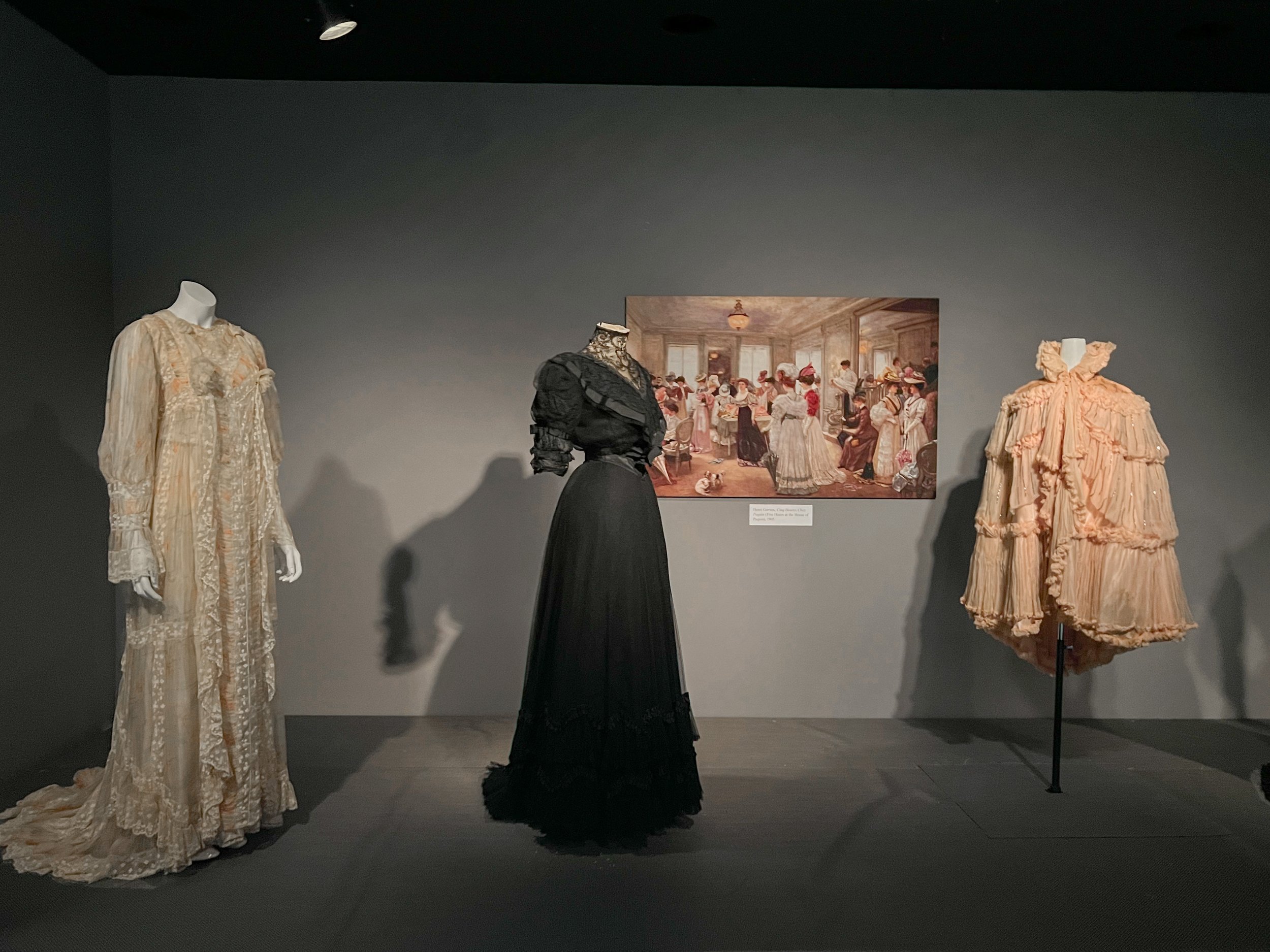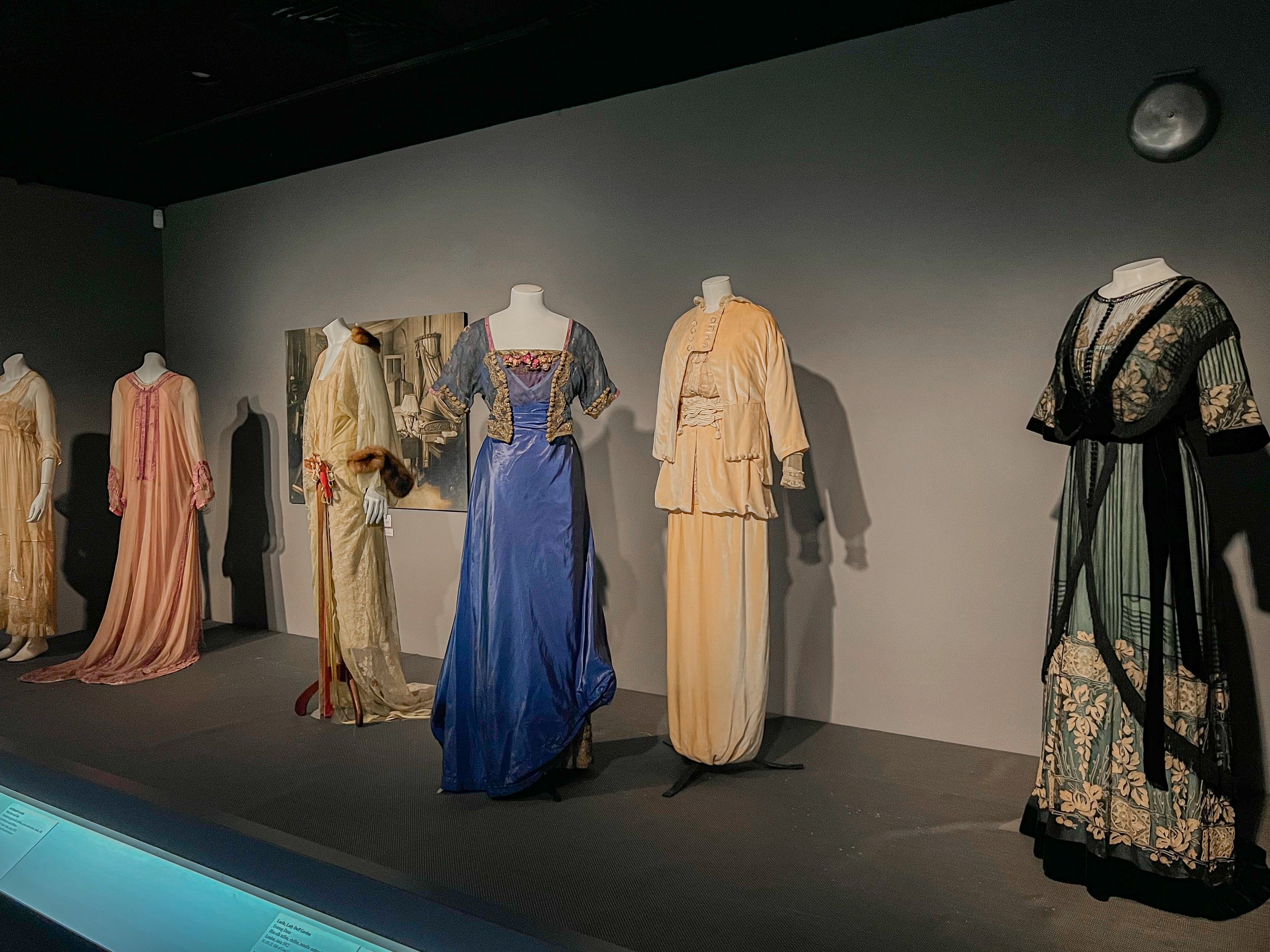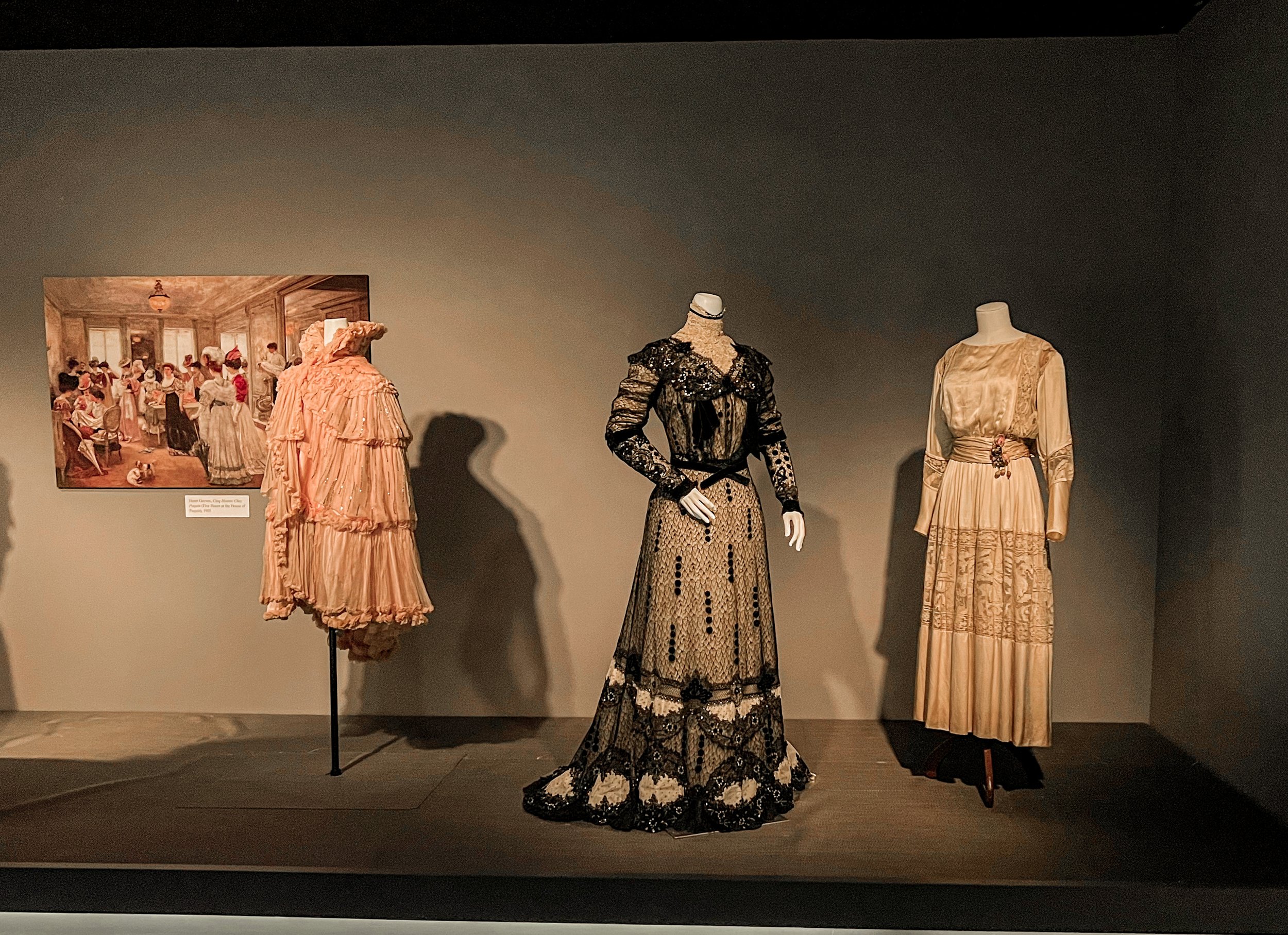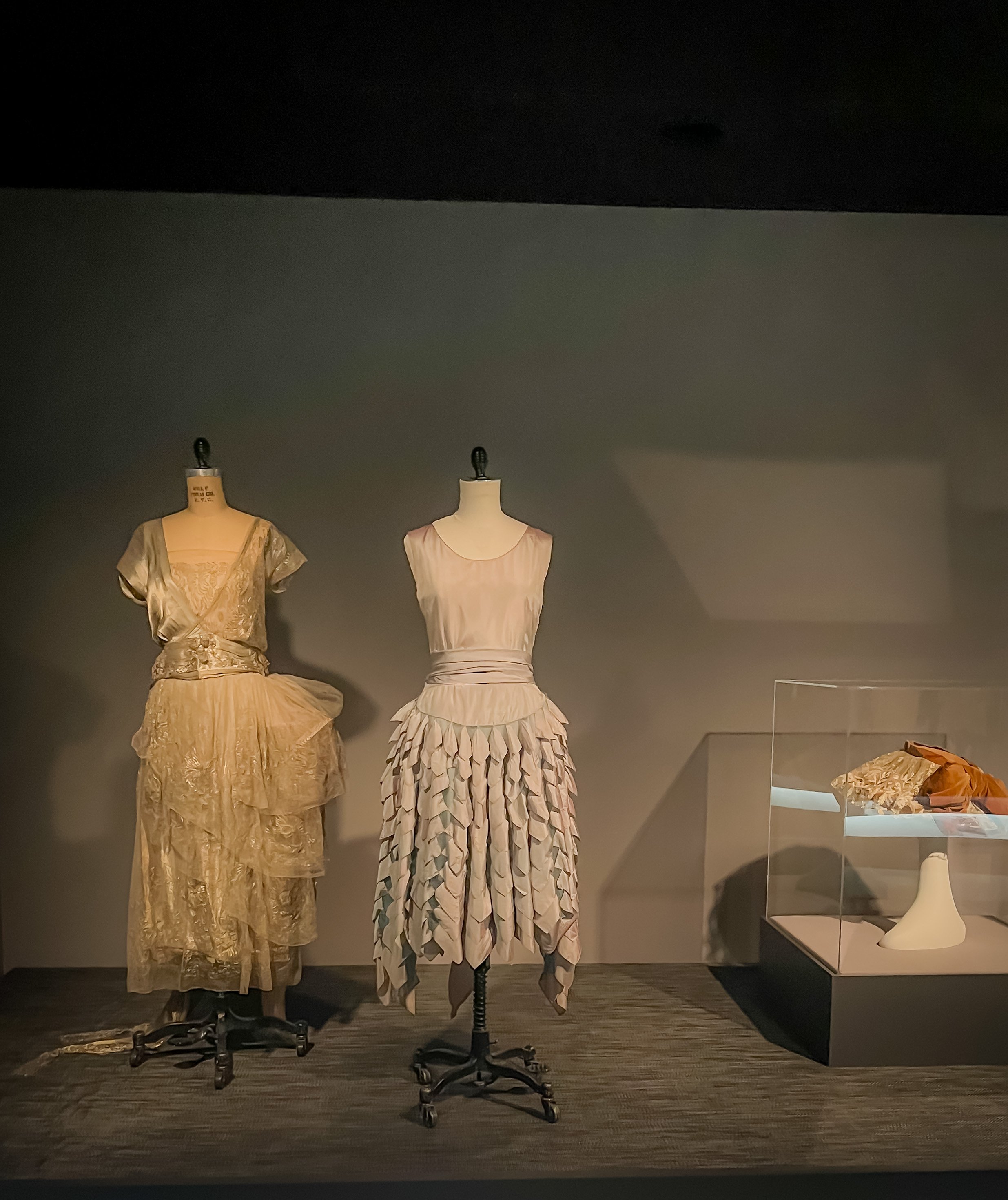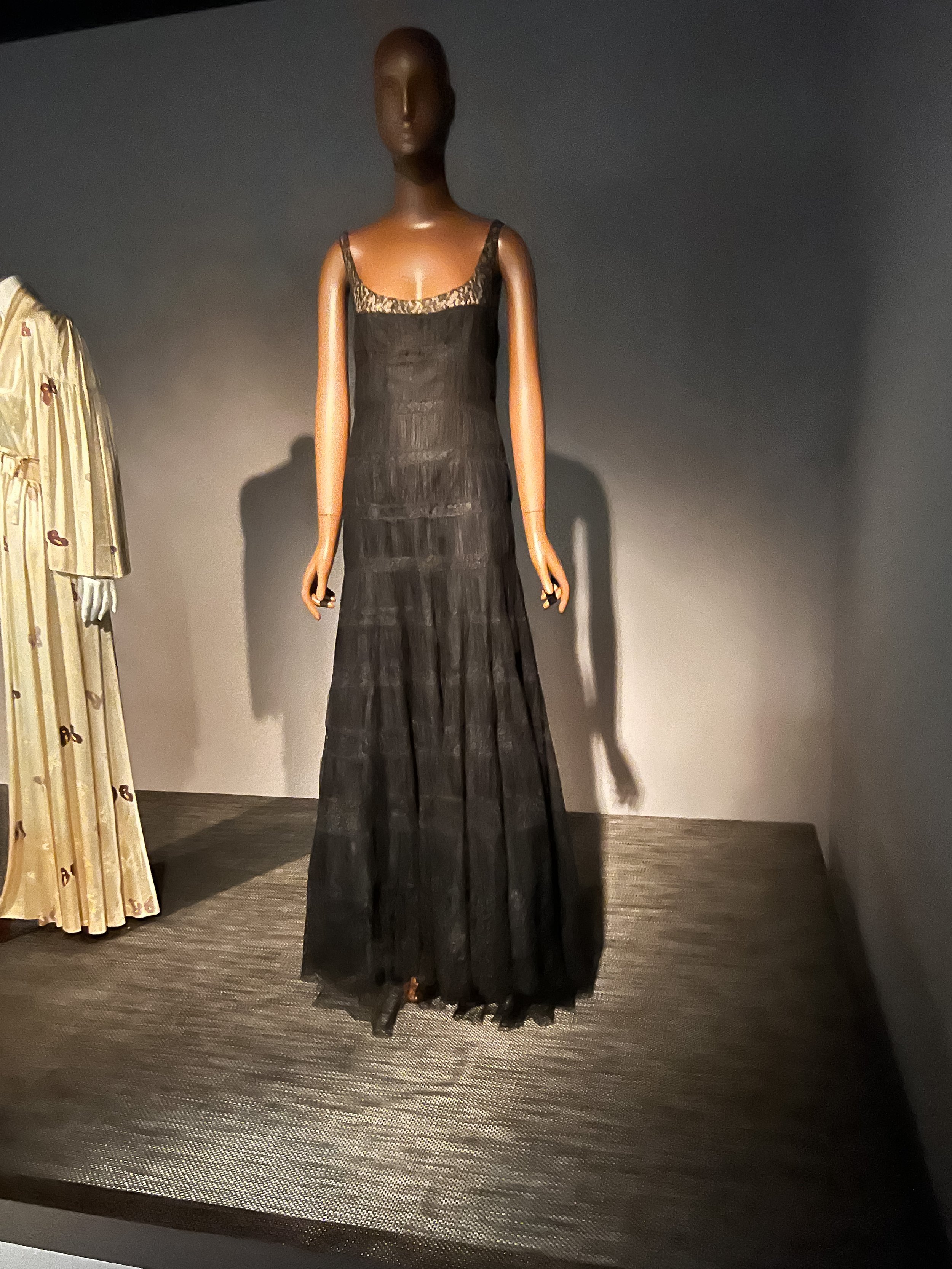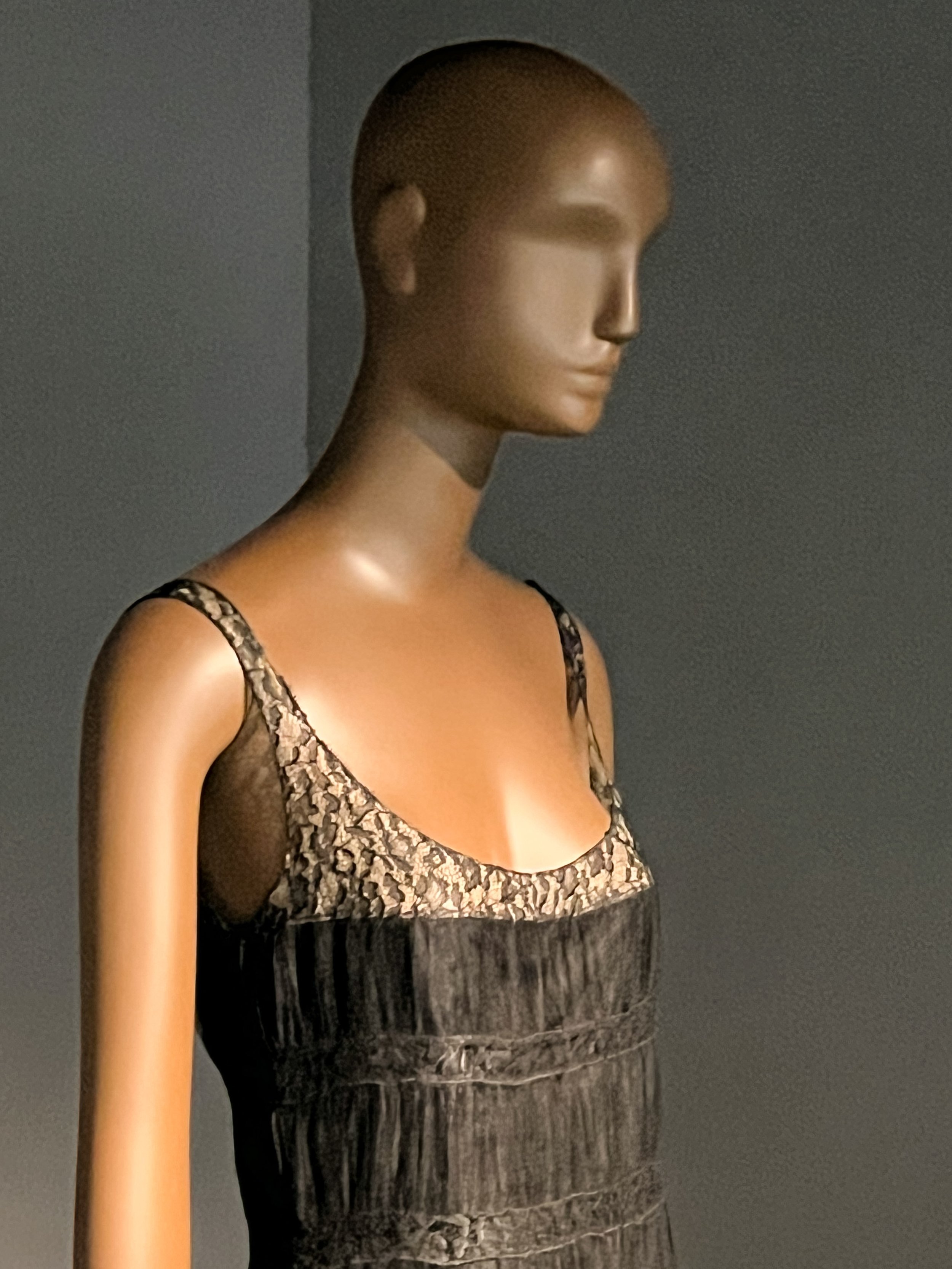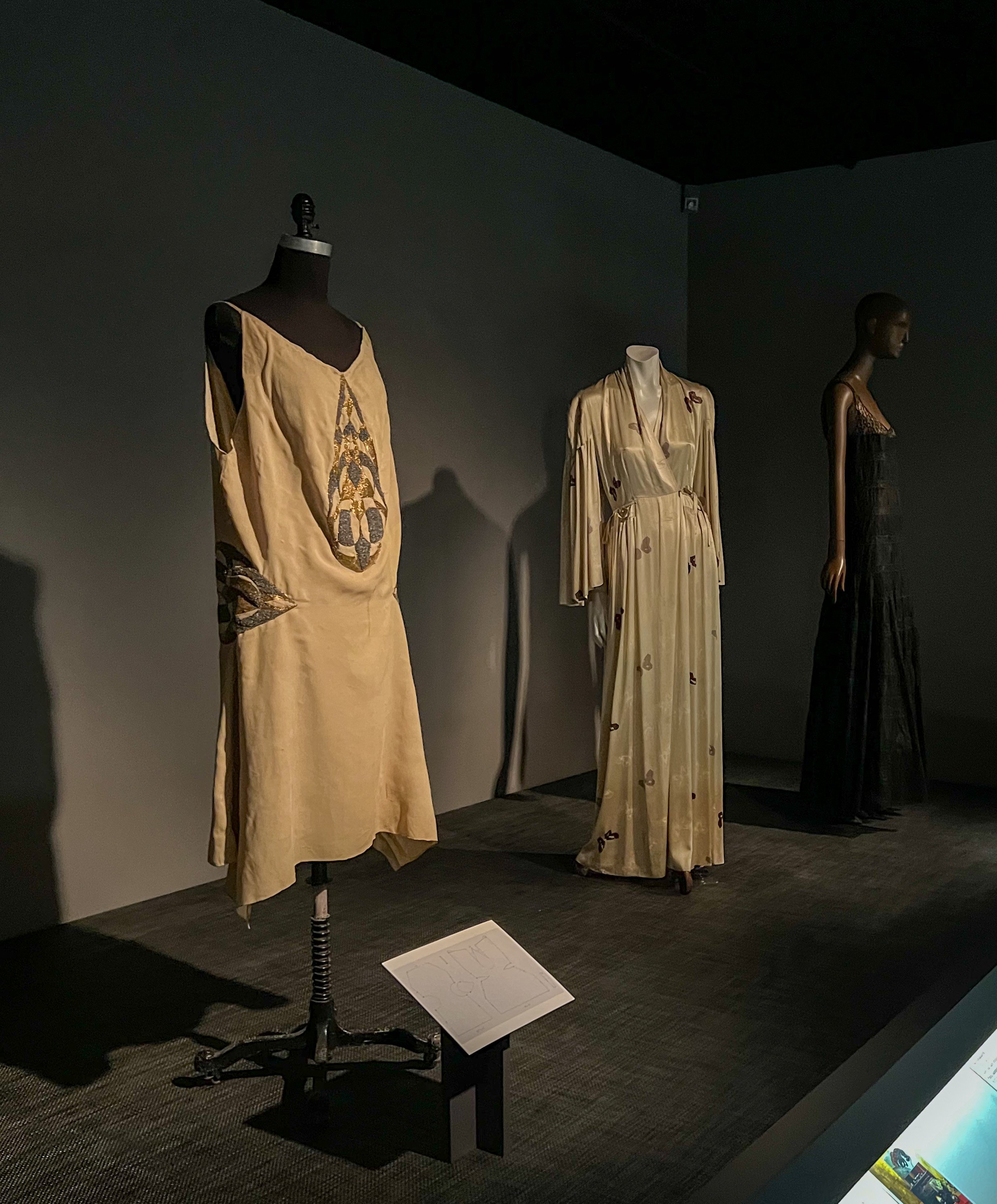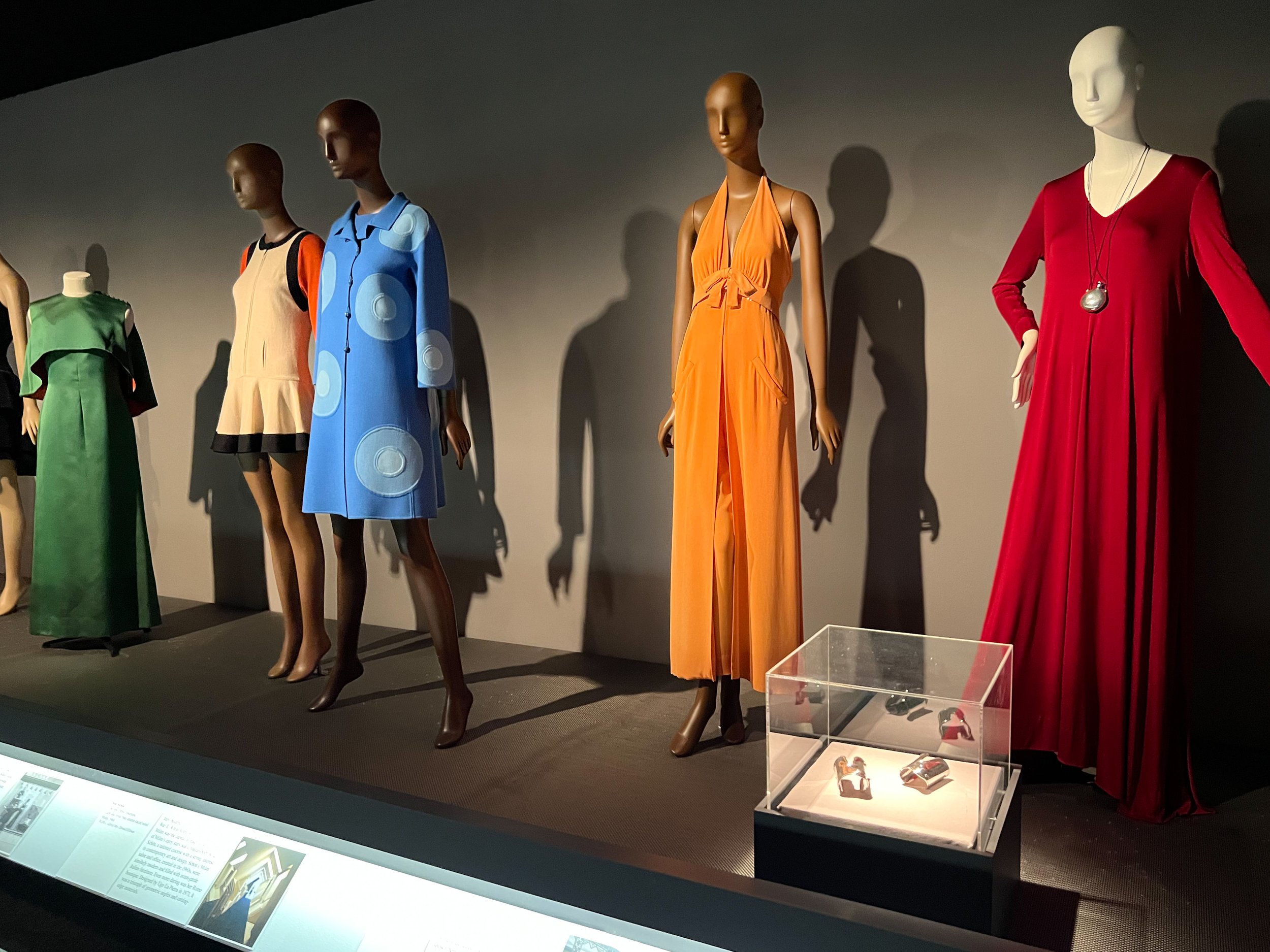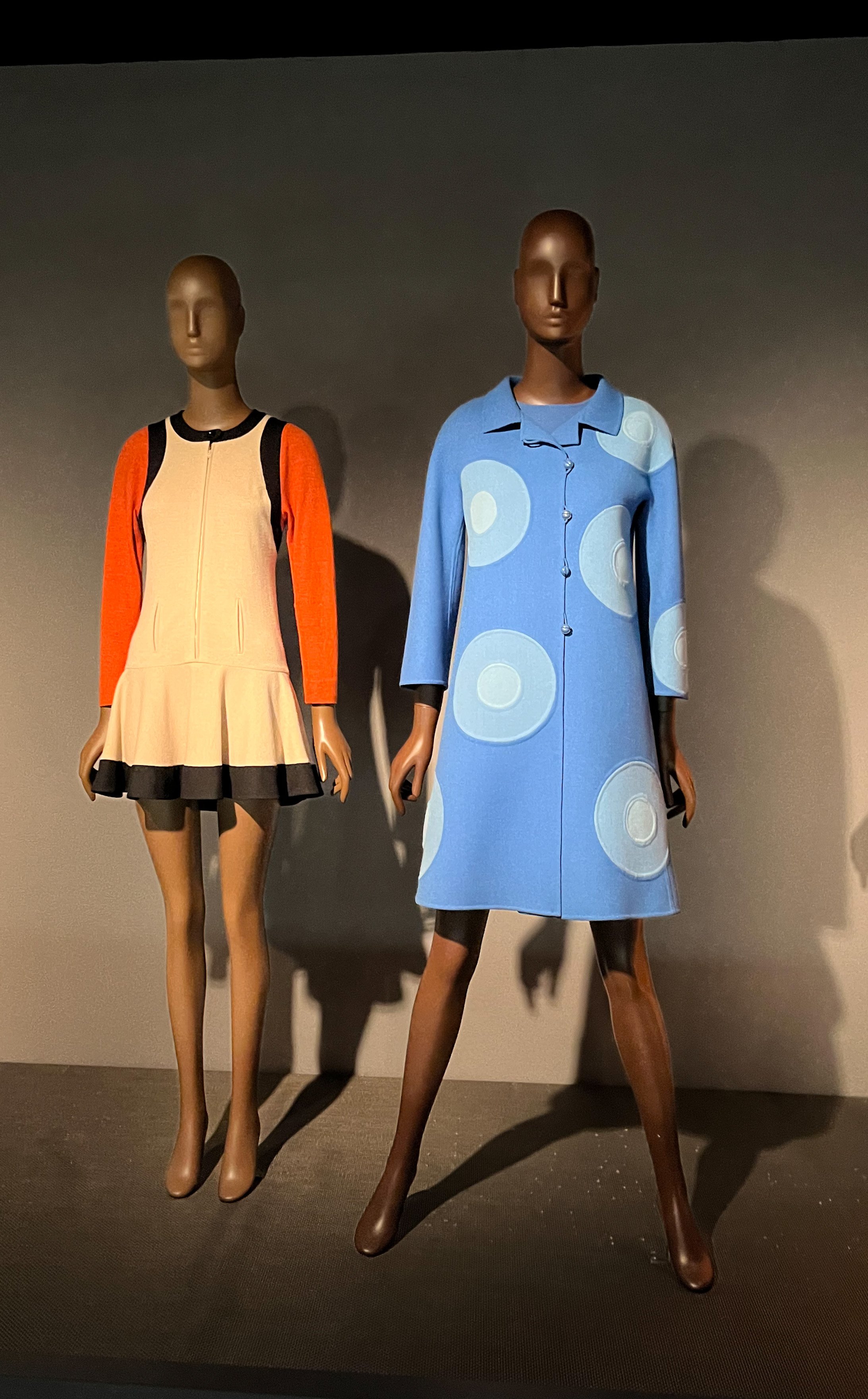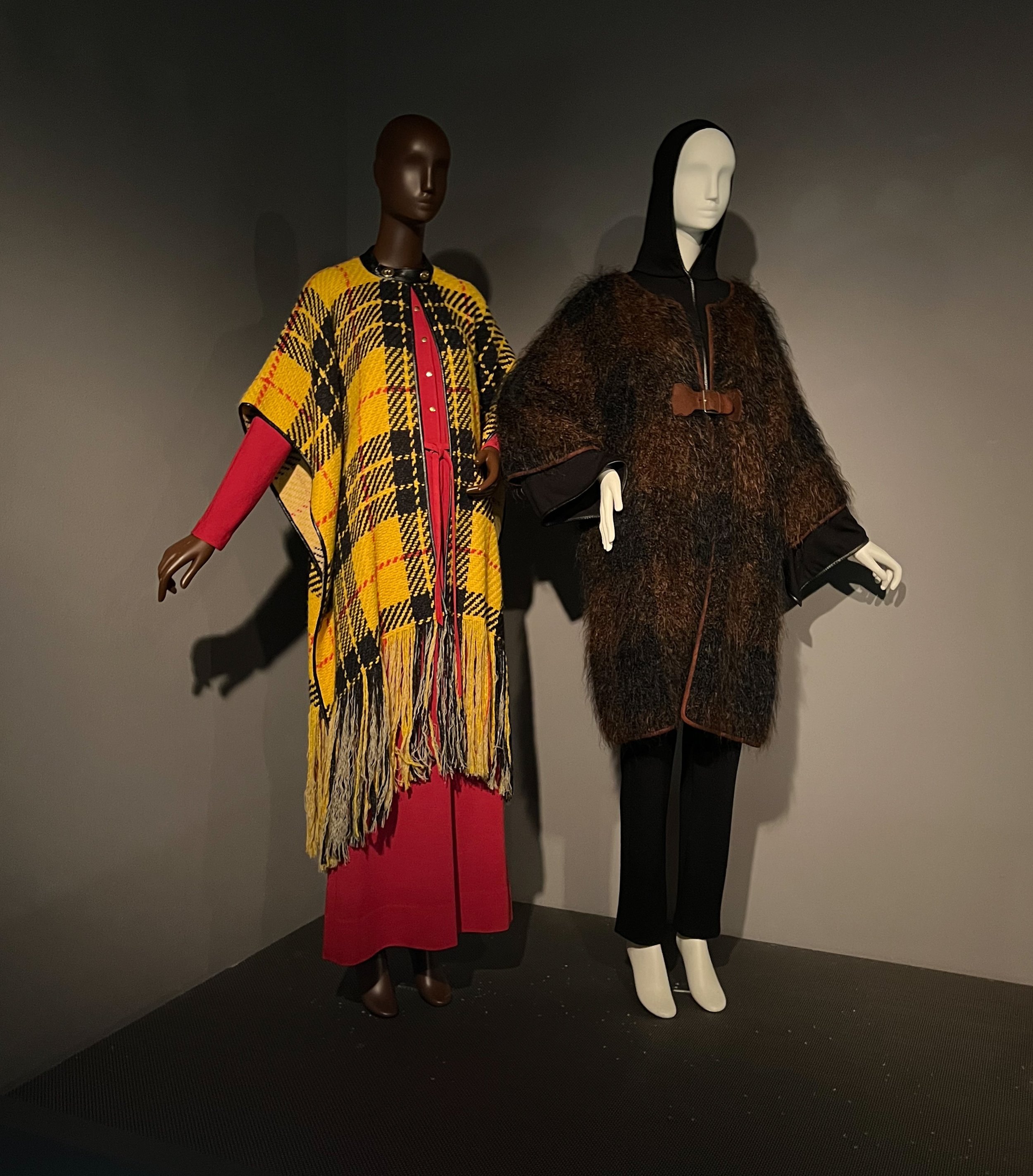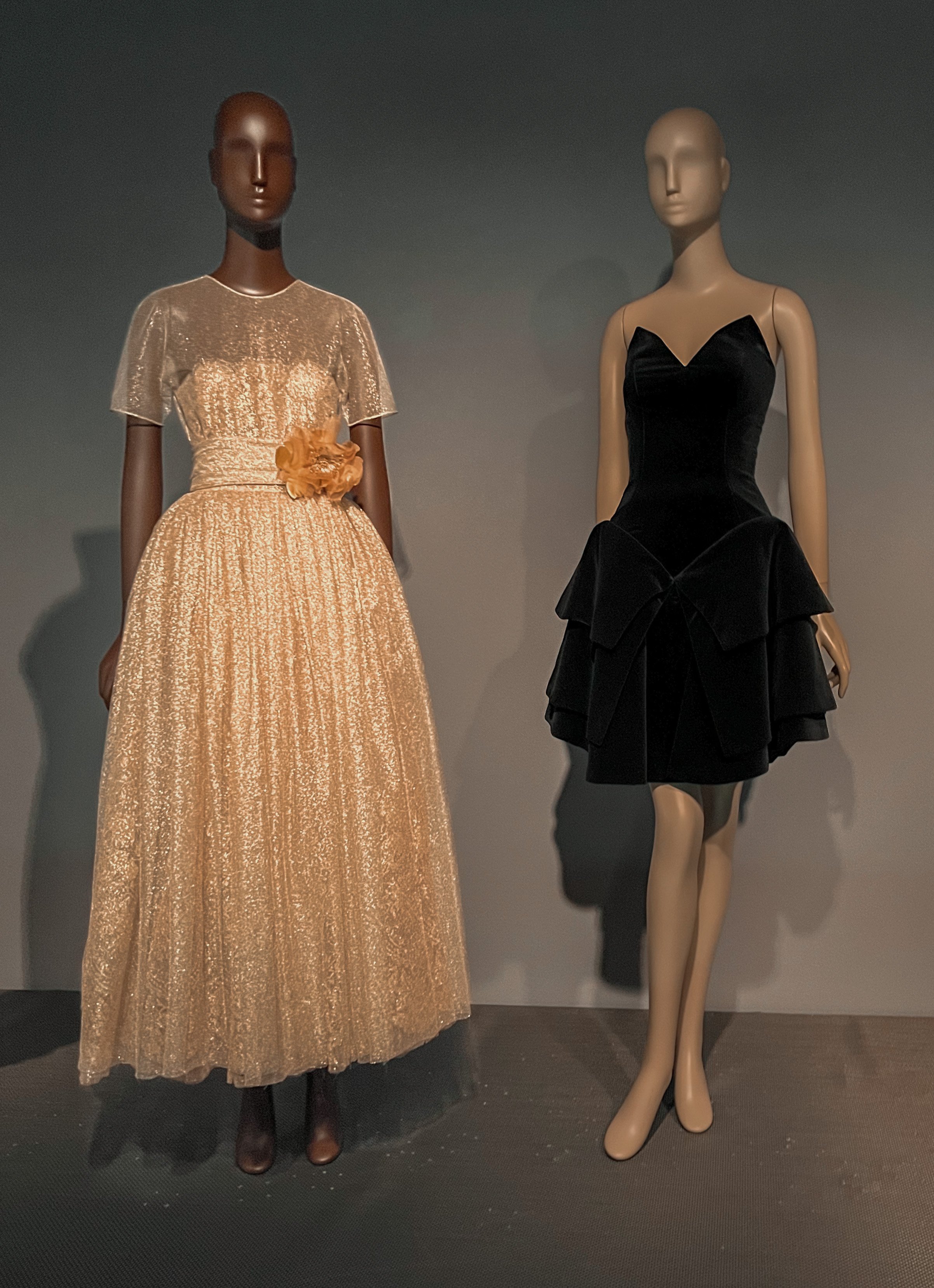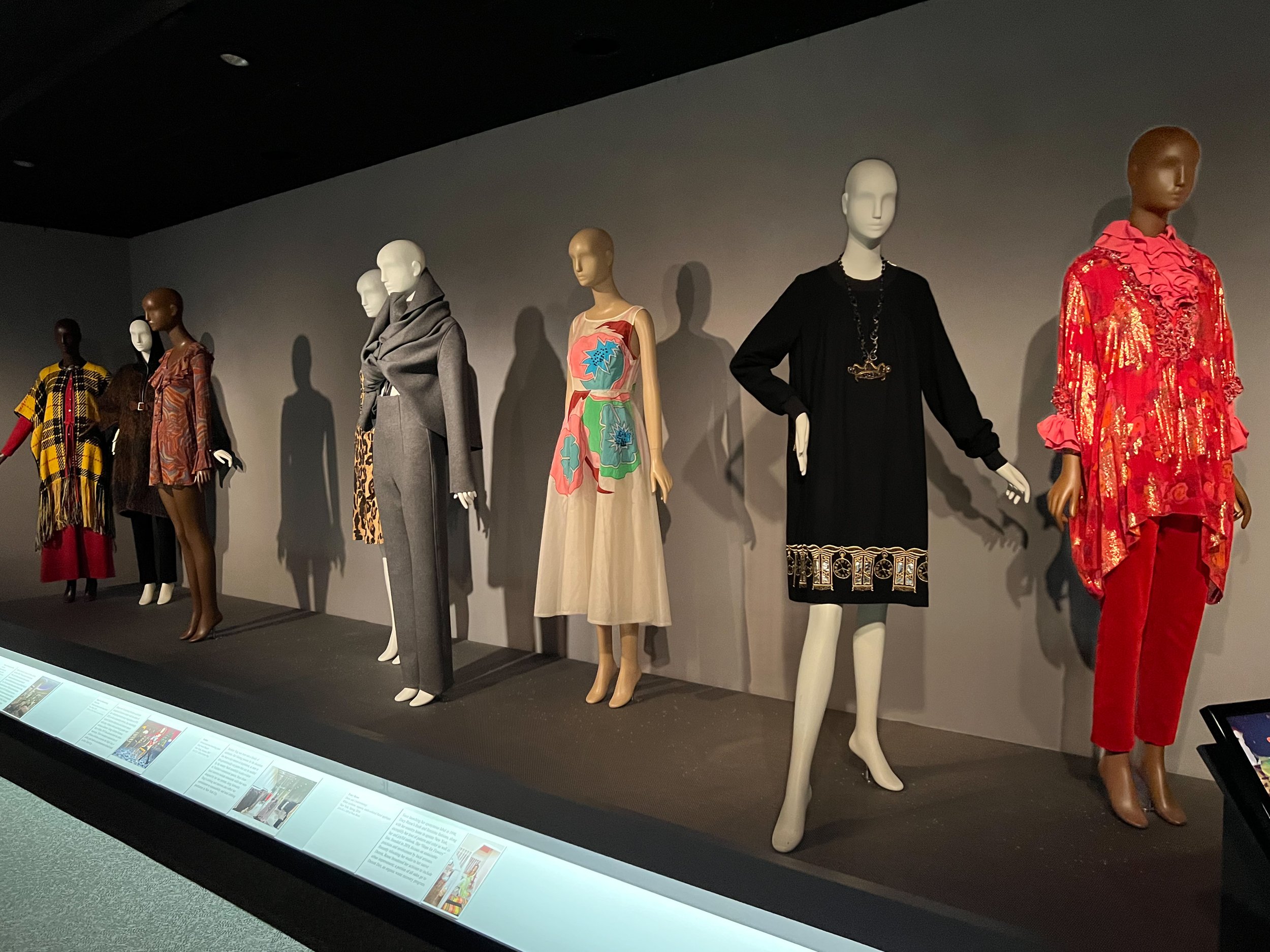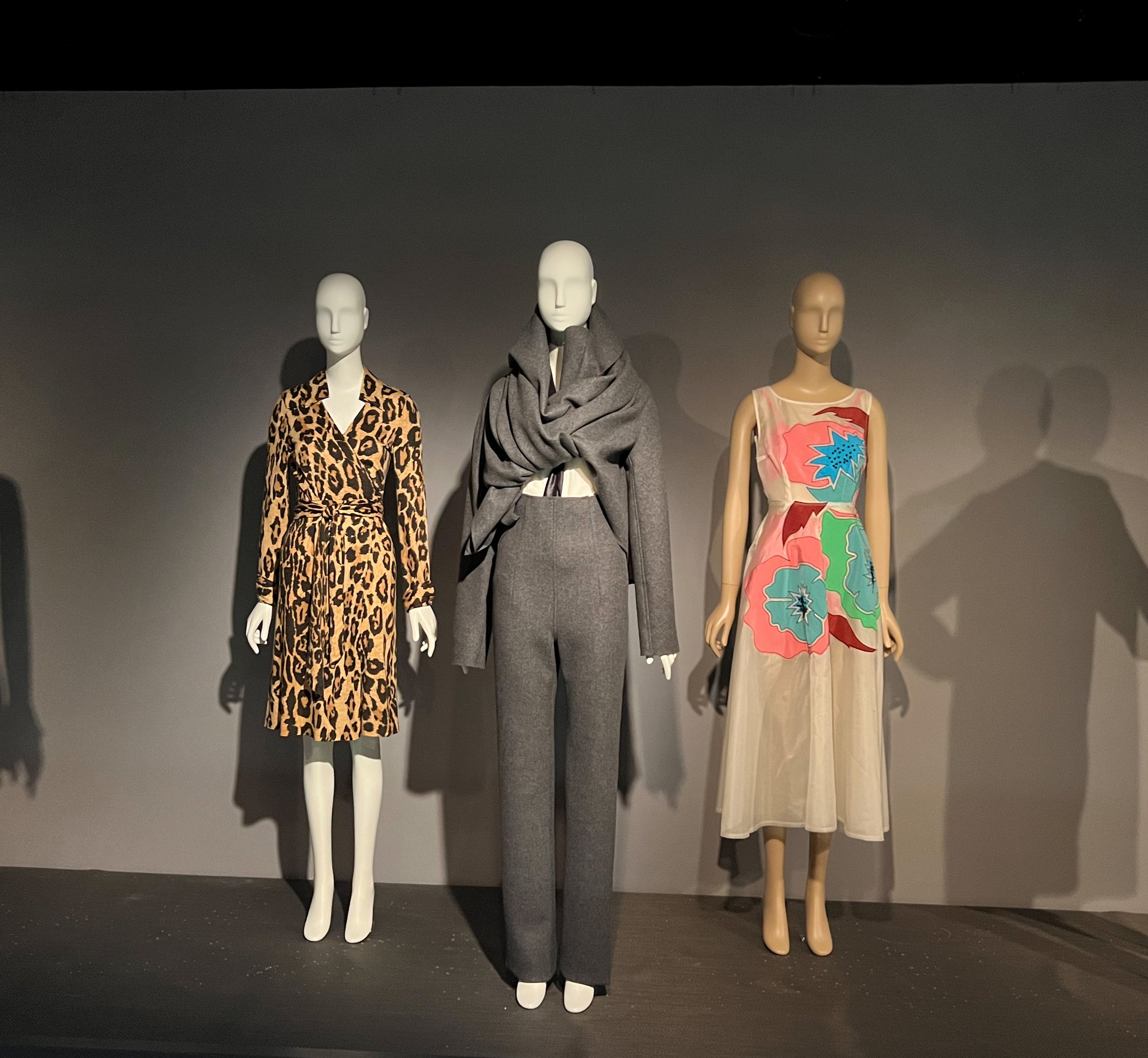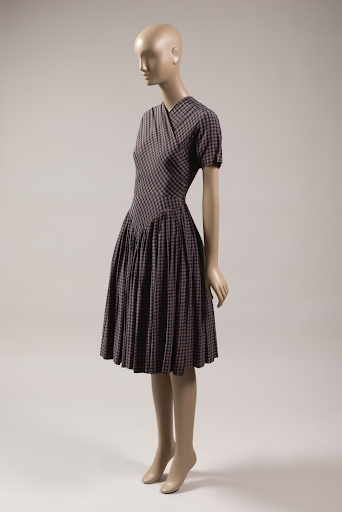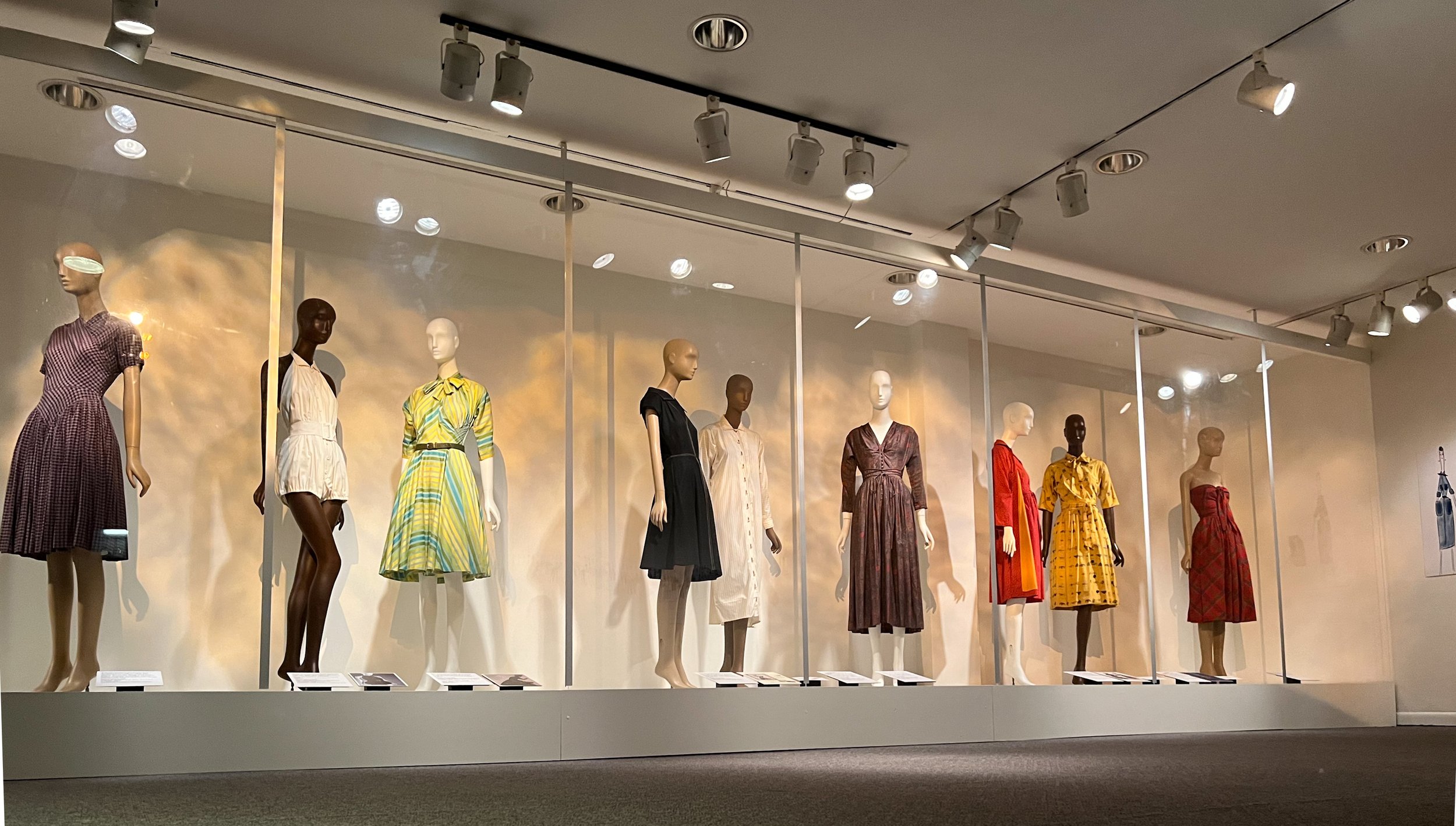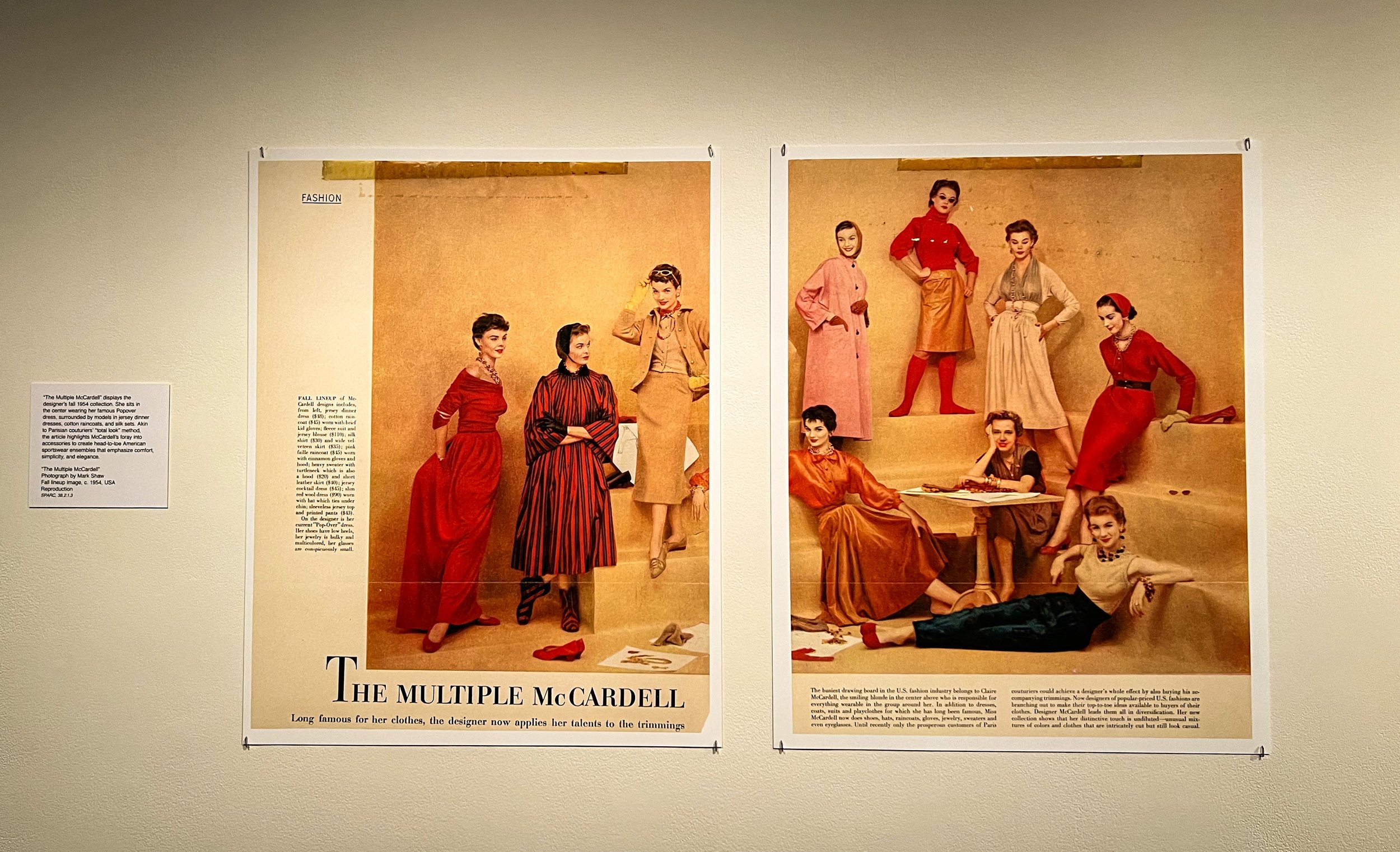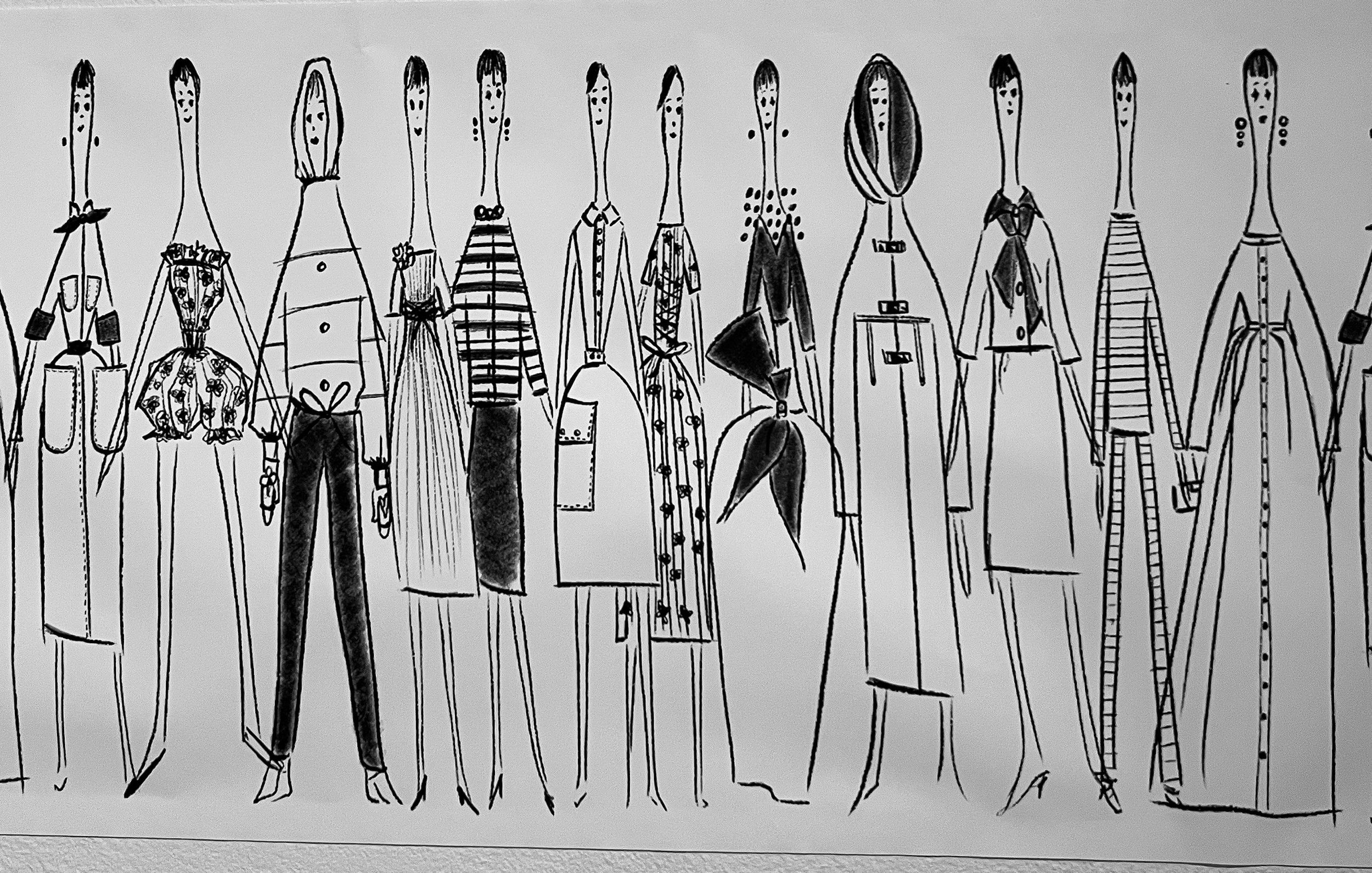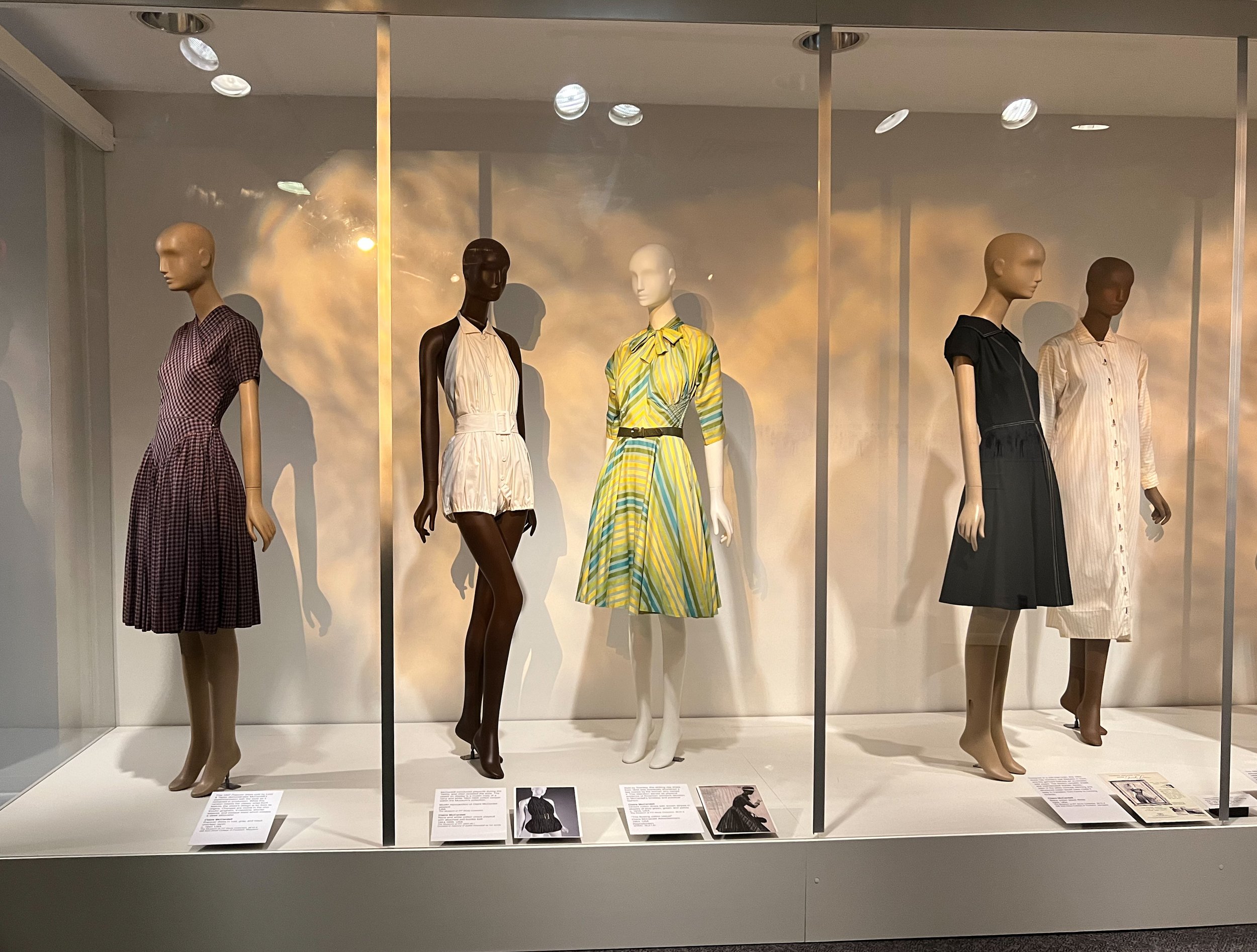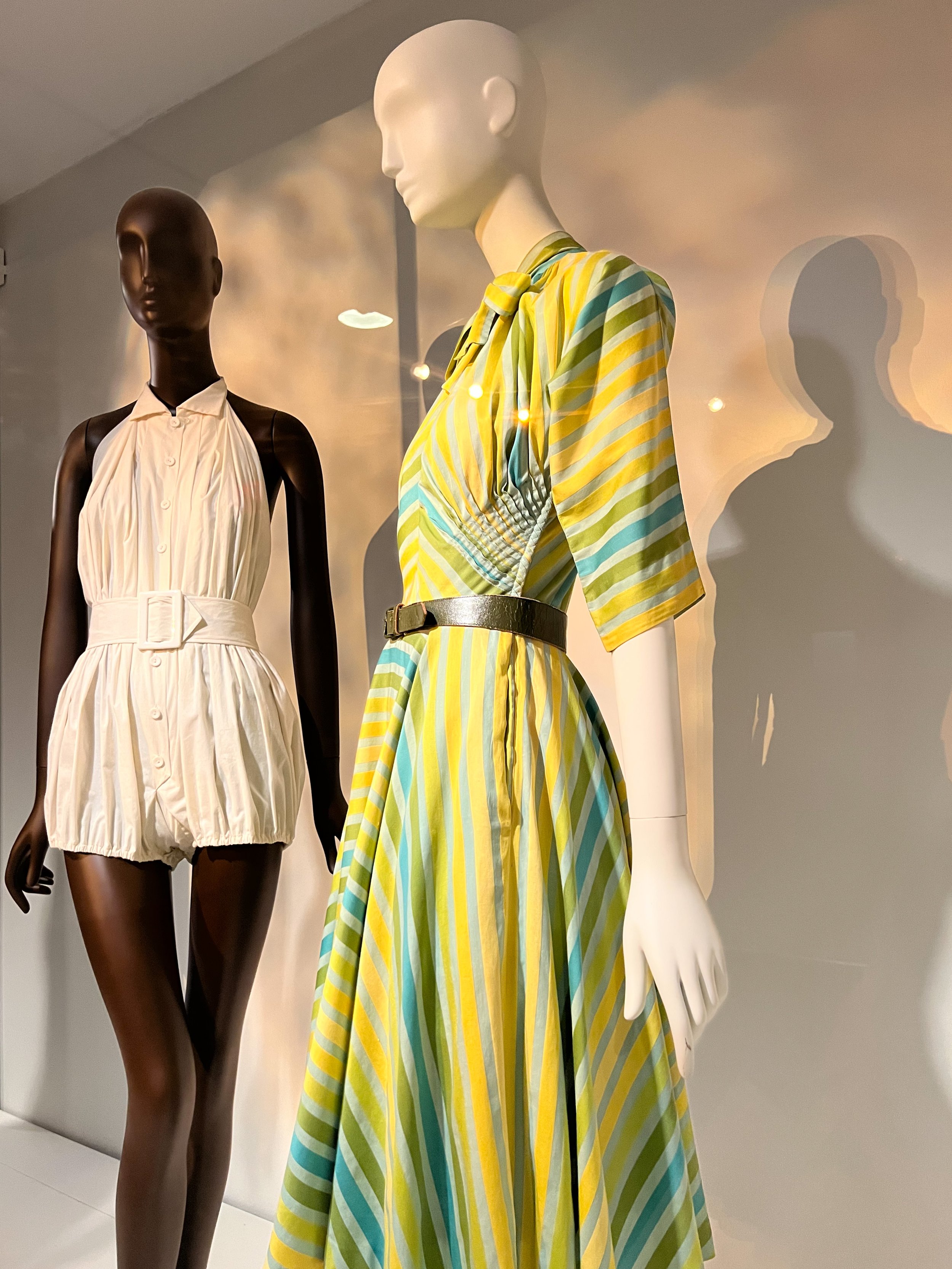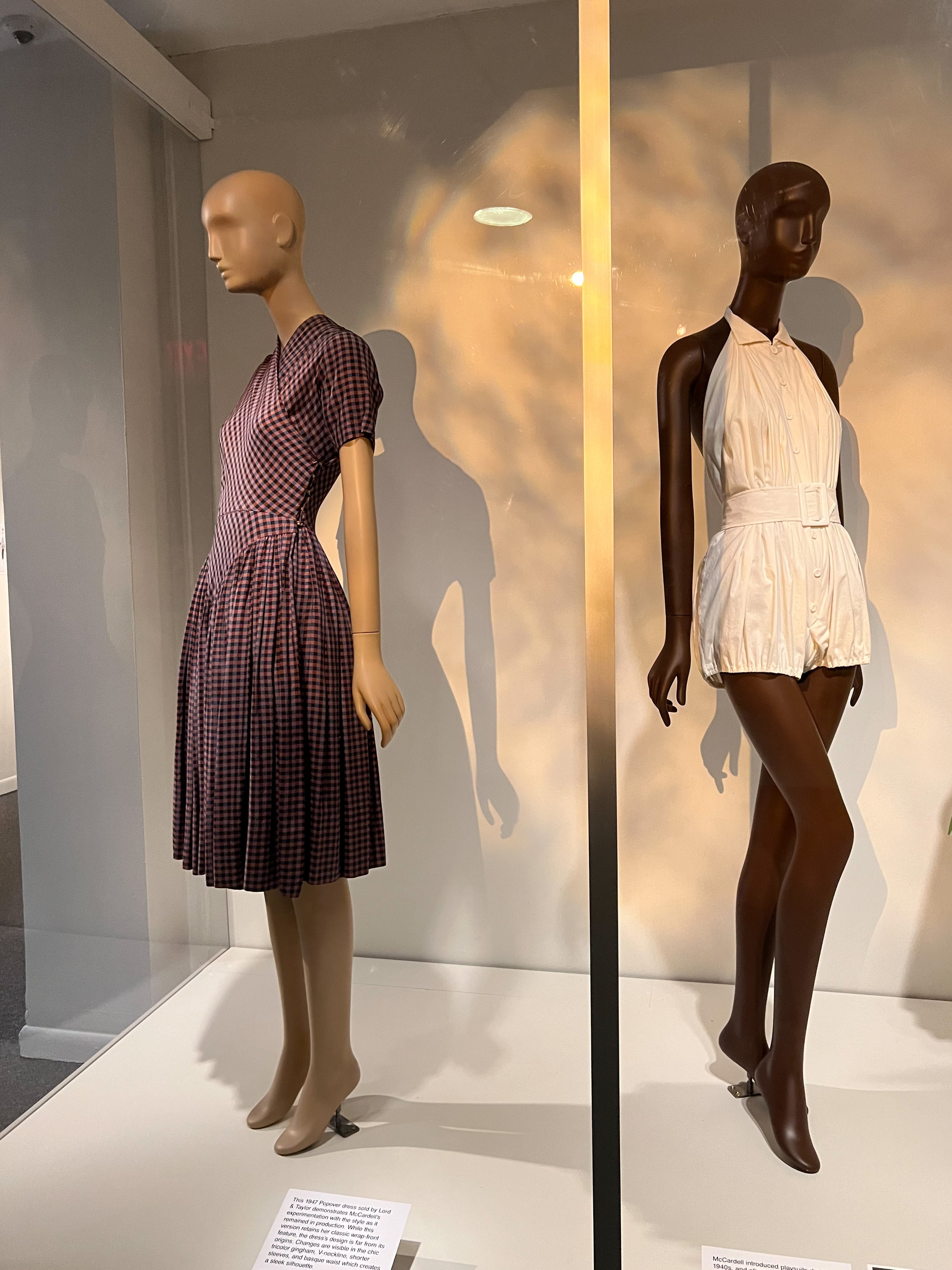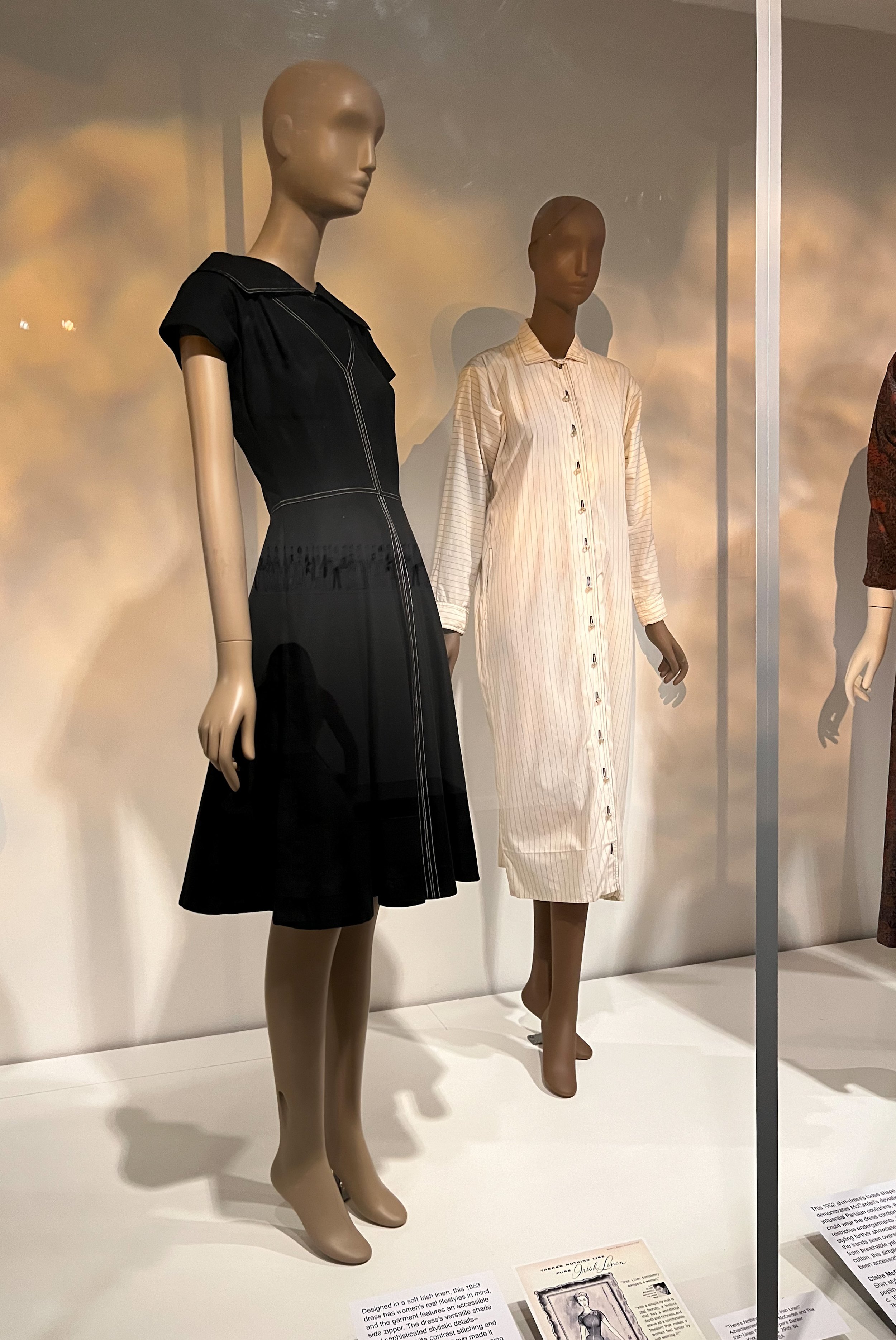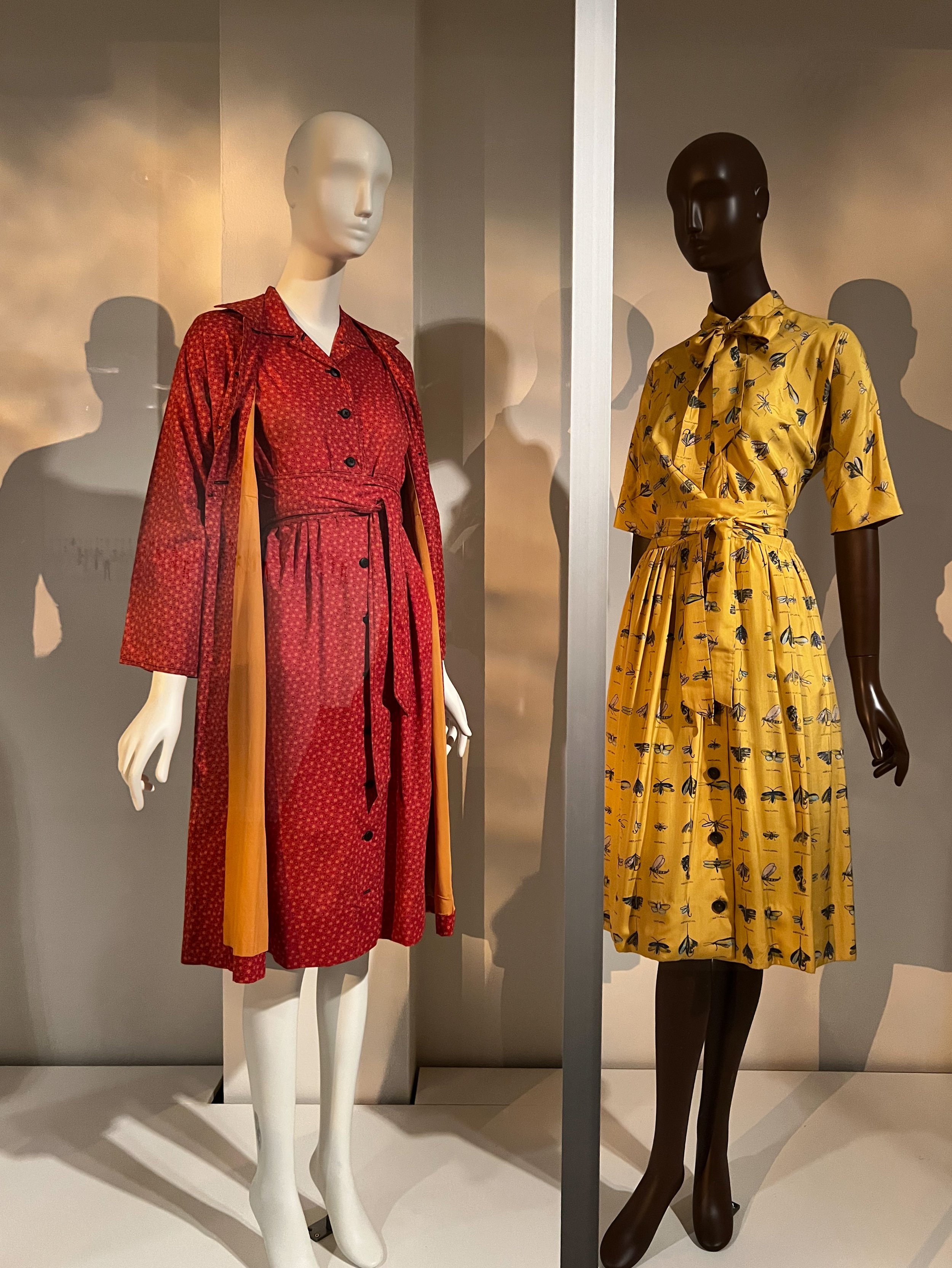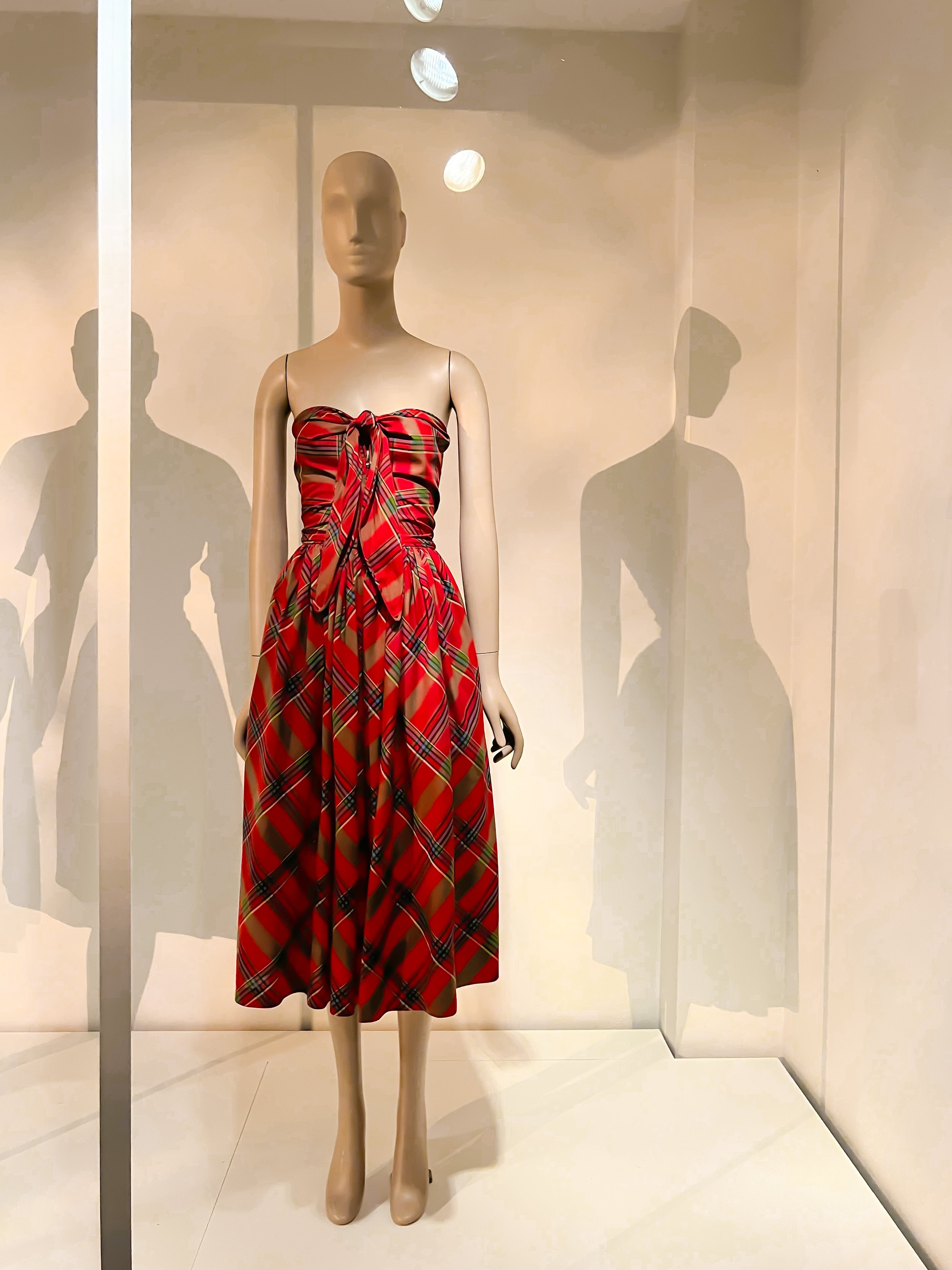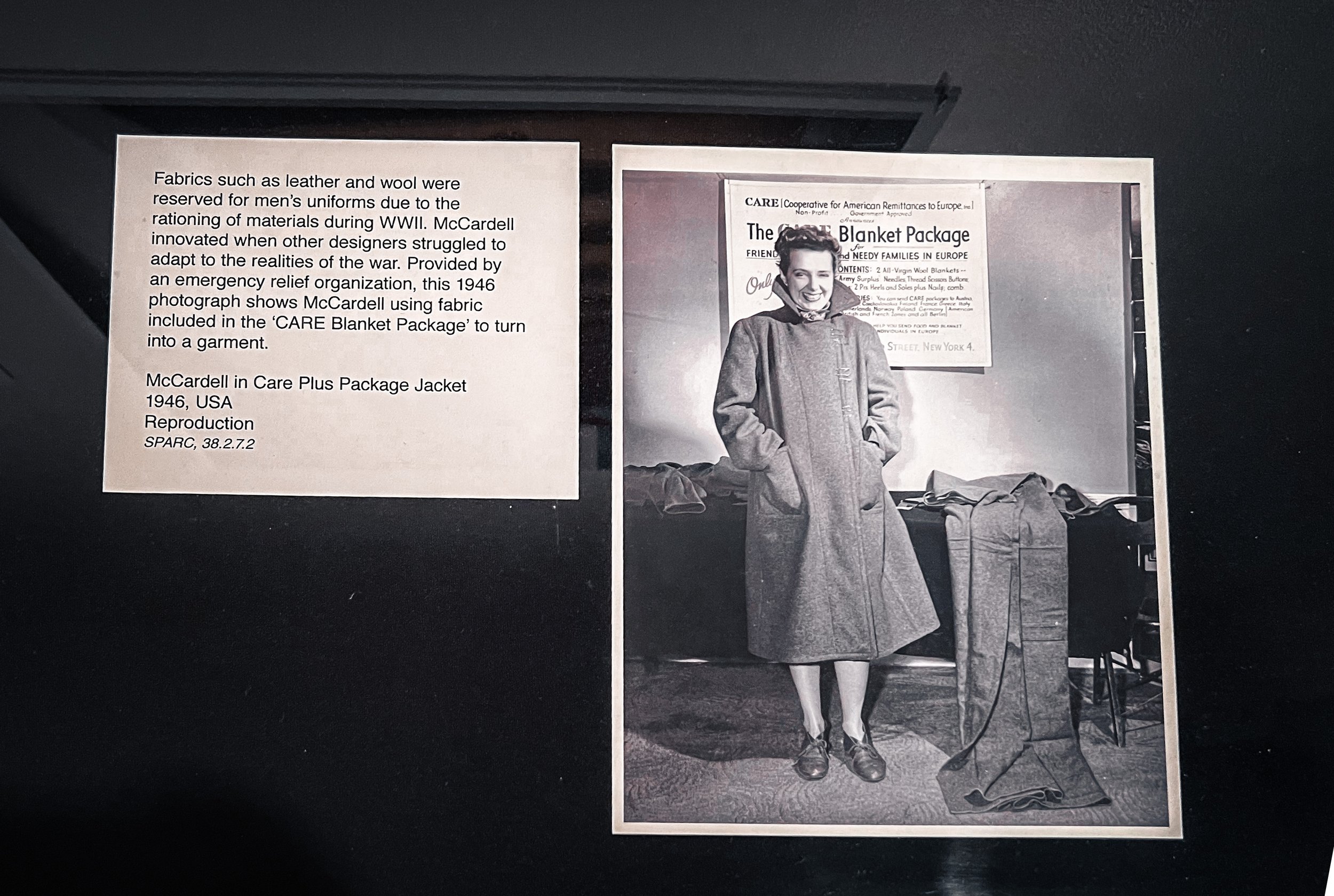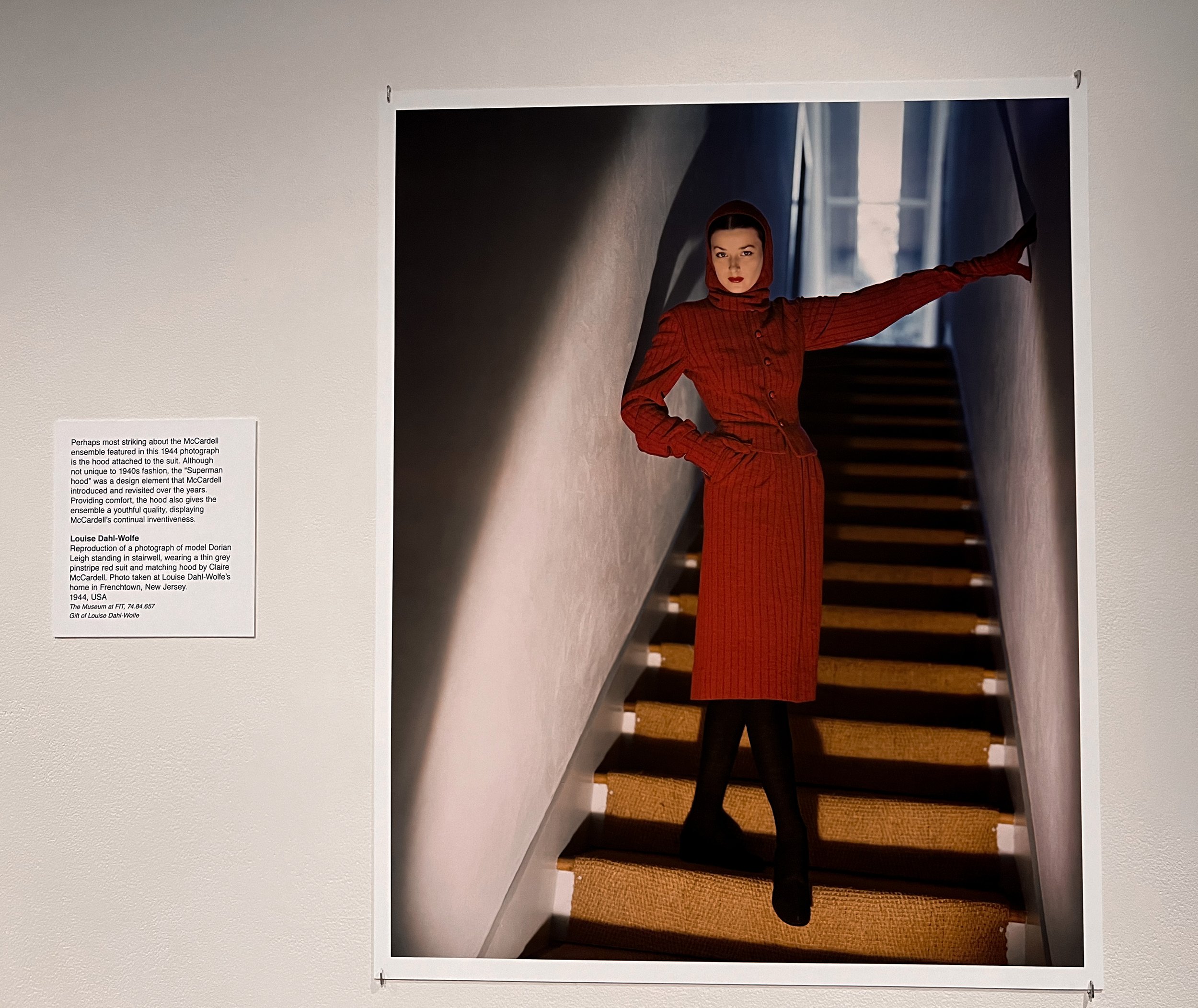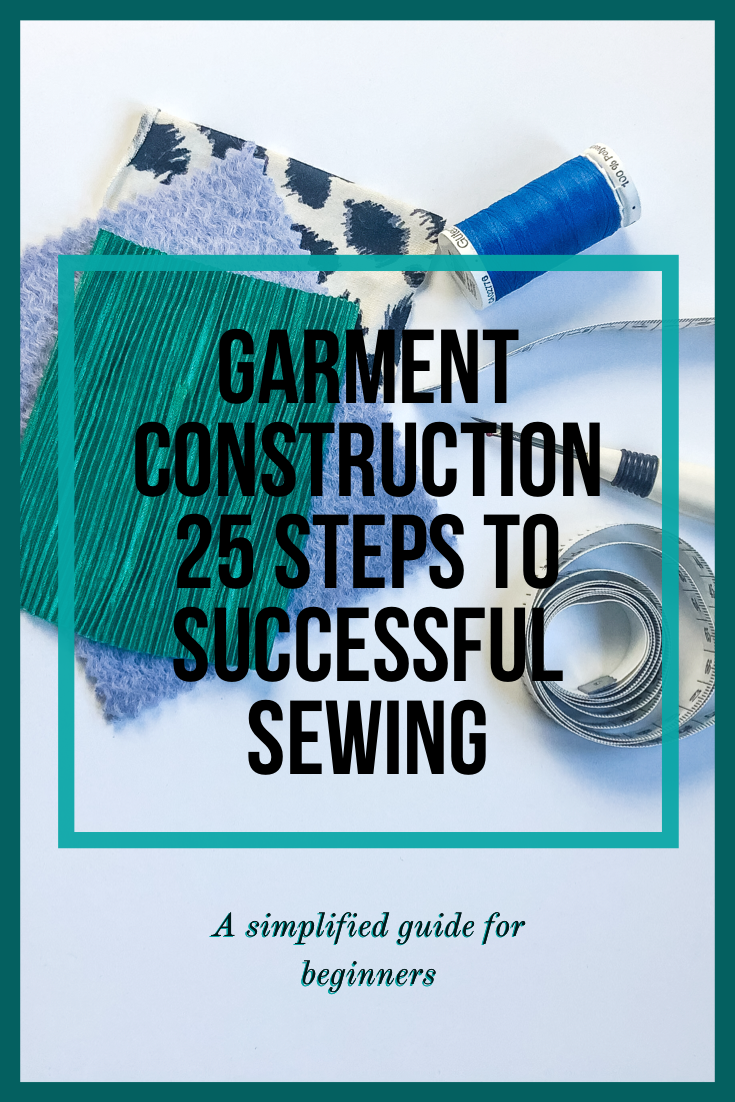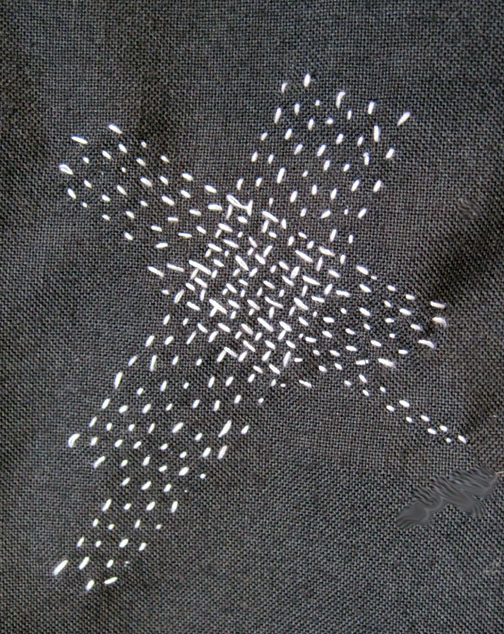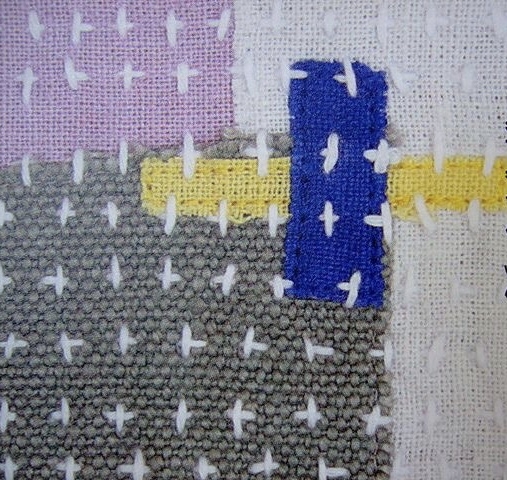Designing Women: Fashion Creators and Their Interiors
The recent exhibit at the Museum at FIT, Designing Women, Fashion Creators and their Interiors, beautifully captures the women behind the designs, her visions, her revolutions, her impact on the world and how her work influenced other women of their time– not in a prescriptive way, but rather by giving women new avenues for self-expression and empowerment. By pushing boundaries in both fashion and interior design, these designers expanded the realm of possibilities for women. By telling the story of the woman behind the designs, her visions, her revolutions, and her impact on the world – it shows how these women, through their work, transformed the spaces we live in and the clothes we wear.
Gowns attributed to Lucile, Lady Duff Gordon; at the Museum FIT exhibit: Designing Women: Fashion Creators and their Interiors
Designing Women: Fashion Creators and Their Interiors, a recent exhibit at the Museum at FIT, explores the interconnectedness of fashion and interior design through the lens of some of the most influential female designers of the 20th century. This exhibit was the second of five fashion exhibits that I saw while in NYC last month. Recently, I wrote about the student curated, Claire McCardell exhibit.
Fashion at its essence is a form of communication. Through it, we can express our identity, ideas, and aspirations. Since fashion reflects the cultural, political, and socio-economic context of a given period, this exhibit provides an opportunity to see how fashion influenced the creative process of some extraordinary twentieth-century fashion creators. While also inspiring a profound appreciation for the artistry and environmental influences that helped to shape their careers.
Gowns attributed to Lucile, Lady Duff Gordon and the Callot Sisters at the Museum FIT exhibit: Designing Women: Fashion Creators and their Interiors
Gowns by Jeanne Pauquin, at the Museum FIT exhibit: Designing Women: Fashion Creators and their Interiors
Understanding the Influence of 20th Century Women Designers
More than just a celebration of fashion, Designing Women, is an exploration of the creative process that reveals how fashion and design are used as a canvas to express views on femininity, comfort, luxury, and even rebellion. By challenging societal norms, the bold and pioneering clothing and interiors, redefined what fashion could be. Transforming not just the way women dressed, but also the way they lived.
You can see this duality in the work of Coco Chanel, for example. An icon of sophisticated simplicity, she prioritized comfort in her designs, while pioneering a new aesthetic of elegance that placed the modern woman at its core. Her Parisian apartment, with its neutral colors, exquisite minimalism, and mix of masculine and feminine elements, echoed the same philosophy. It portrayed luxury in the realm of comfort, serving as a physical extension of her avant-garde vision for women's fashion.
Coco Chanel, and Elsa Schaiparelli (right) at the Museum FIT exhibit: Designing Women: Fashion Creators and their Interiors
Detail Chanel Black Lace Evening Dress, C. 1932
Madeleine Vionnet, Schaiparelli, and Chanel dresses,
Chanel’s work was juxtaposed with designers such as Madeleine Vionnet, Jeanne Paquin, Elizabeth Hawes, Bonnie Cashin, Anna Sui, and Elsa Schiaparelli. Schiaparelli’s home, with its whimsical and provocative elements, was such a reflection of her Surrealist leanings. Underscoring how each woman's living space and their sartorial creations are truly an extension of their fashion ethos.
Placed within the broader historical context of the twentieth century, the curator, Deputy Director, Patricia Mears has skillfully incorporated the prevailing social, cultural, and artistic movements of the time, enabling visitors to better understand the designers' motivations, inspirations, and the impact their work had on society. This historical framework serves as a valuable backdrop, enhancing our appreciation for the transformative power of design and how it shaped the spaces we live in and the clothes we wear today.
As I meandered through the gallery, I could more fully appreciate how the personal philosophies of the designers became intrinsically woven into their work, and how their interiors were both a reflection and an extension of their personal styles. Not as separate spheres of private and public, fashion and interiors, but as a single canvas of personal expression for their revolutionary ideas. With each vignette, I looked for parallels and differences, for echoes and deviations. Remembering that each of these women was not only creating beautiful clothing, but also a new paradigm for women in their time.
Exploring Fashion and Interior Design
I often encourage my fashion students to go to museums and to look beyond the visual aesthetics and to think about the cultural, social, and historical context. To engage with the exhibition not just as an observer, but as a student of history and culture. Above all, I ask them to remember, every designer leaves a bit of herself in her work. Our job is to find and understand it.
Pauline Trigère, Mary Quant, Mila Schoën, Irene Galitzine, and Halston with Elsa Peretti “Bone” cuffs and “Bottle Open Bottle” Necklace.
Mary Quant and Mila Schön
Bonnie Cashin ensembles.
Gowns by Anouska Hemple and Carolyne Roehm.
Bonnie Cashin, Barbara Hulanicki for Biba, Diane von Furstenberg, Yeohlee, Tracy Reese, Anna Sui.
Diane von Furstenberg, Yeohlee, and Tracy Reese.
How Designing Women Transformed Fashion and Interior Design
Drawn from the Museum at FIT’s permanent collection, this exhibit beautifully captures the women behind the designs, her visions, her revolutions, her impact on the world and how her work influenced other women of their time– not in a prescriptive way, but rather by giving women new avenues for self-expression and empowerment. By pushing boundaries in both fashion and interior design, these designers expanded the realm of possibilities for women. By telling the story of the woman behind the designs, her visions, her revolutions, and her impact on the world – it shows how these women, through their work, transformed the spaces we live in and the clothes we wear.
I left with a renewed understanding of the transformative power of fashion, the significance of personal spaces, and the enduring legacies of these influential women. Designing Women is not only a celebration of their accomplishments but also a testament to the ongoing dialogue between fashion, art, and the spaces in which creativity flourishes. By highlighting these intertwined narratives, the exhibit encourages viewers to think more deeply about the cultural and historical contexts that these designers navigated, thus providing a comprehensive understanding of their contributions.
/\/\/\/\/\/\/\/\/\/\/\/
Hilarie
Designing Women: Fashion Creators and Their Interiors
At the Museum at FIT, November 30, 2022- May 14, 2023
Claire McCardell Exhibition at FIT: Exploring Fashion's Pioneer
In the world of fashion, certain designers leave an indelible mark on the industry, shaping trends and redefining the way we dress. One such visionary is Claire McCardell, whose groundbreaking designs continue to inspire and captivate fashion enthusiasts even today. In April, I was able to see a captivating exhibition celebrating the remarkable legacy of Claire McCardell, at the Museum at the Fashion Institute of Technology (FIT): Claire McCardell, Practicality Liberation, Innovation. This small exhibit showcased some of her revolutionary designs while highlighting her enduring influence on contemporary fashion.
Claire McCardell
Practicality, Liberation, Innovation
Claire McCardell, Popover dress, rayon, brass hooks & eyes, c. 1947, Lord & Taylor, American, founded 1826, Gift from Hood College of Frederick, Maryland, 96.61.6
In the world of fashion, certain designers leave an indelible mark on the industry, shaping trends and redefining the way we dress. One such visionary is Claire McCardell, whose groundbreaking designs continue to inspire and captivate fashion enthusiasts even today. In April, I was able to see a captivating exhibition celebrating the remarkable legacy of Claire McCardell, at the Museum at the Fashion Institute of Technology (FIT): Claire McCardell, Practicality Liberation, Innovation. This small exhibit showcased some of her revolutionary designs while highlighting her enduring influence on contemporary fashion.
As a lifelong McCardell fan, the is the second exhibit of her work that I have seen in six months. Before then, it had been about 30 years. Needless to say, I was thrilled.
A Pioneer in American Fashion:
Claire McCardell, born in 1905, emerged as a pivotal figure in American fashion during the mid-20th century. Known for her avant-garde approach to design, McCardell challenged conventional norms by prioritizing comfort, practicality, and freedom of movement in her garments. She played a significant role in shaping the modern concept of American sportswear, which emphasized simplicity, functionality, and wearability.
The exhibition was organized by four college seniors in the undergraduate program in Art History and Museum Professions (AHMP Program) at FIT. The garments showcased, are culled from the FIT Study Collection, with additional historical records from the Gladys Marcus Library’s Special Collection & College Archives.
Organized into three sections, Practicality Liberation and Innovation, this exhibit offers visitors a unique opportunity to witness the evolution of McCardell’s career and gain insights into her creative process. The curation captures McCardell's distinctive style, highlighting her groundbreaking use of fabric, innovative garment construction techniques, and keen eye for detail.
McCardell's designs were characterized by their clean lines, unstructured silhouettes, and inventive use of fabrics such as denim, menswear suiting woolens, and cotton. She introduced several innovative design elements that are now considered industry standards. For instance, the use of unique closures, such as grommets and hooks and eyes, spaghetti string ties and well-proportioned pockets are all McCardell-isms. The ballet flat as a shoe style, now a staple in every woman's wardrobe, can be traced back to McCardell's ingenious creations. She also popularized the concept of mix-and-match separates, allowing women to effortlessly combine different pieces to create versatile outfits.
Challenging Norms and Promoting Individuality: McCardell's designs not only prioritized comfort and practicality but also challenged societal norms, encouraging individuality and self-expression. She designed clothing that catered to the changing needs of women, both in domestic and public spheres, and even adhered to war rationing guidelines. By liberating women from cumbersome and restrictive clothing, McCardell truly transformed the fashion landscape. Her emphasis on functionality and ease of wear continues to resonate with modern designers, ensuring her lasting influence.
Below is a gallery of images of the garments.
Beyond showcasing McCardell's designs, the exhibition walls and tables were lined with reproductions of photographs as well as advertisements, flyers, newspaper clippings and letters to place the social and cultural context in which her work emerged. Visitors were encouraged to contemplate the impact of World War II on fashion and witness how McCardell's designs responded to the era's challenges, embracing a sense of optimism and liberation.
Claire McCardell's trailblazing designs serve as a source of inspiration for students, designers and enthusiasts alike. Her ability to bridge the gap between high fashion and practicality continues to influence contemporary fashion, encouraging the exploration of innovative techniques and the creation of garments that empower individuals to express their unique style.
The Claire McCardell exhibition at the Museum at FIT is a testament to the enduring legacy of this remarkable designer. Her contributions to American fashion, her innovative design philosophy, and her unwavering commitment to creating comfortable yet stylish clothing continue to inspire and captivate fashion enthusiasts and designers alike. Exploring the exhibition provides a glimpse into McCardell's revolutionary designs and the profound impact she had on shaping the fashion industry. Claire McCardell's remarkable vision serves as a reminder that fashion can transcend trends and that timeless design can continue to shape and influence the way we dress for generations to come.
/\/\/\/\/\/\/\/\/\/\/\/
Hilarie
To see more photos, follow the hashtag on social media. #clairemccardellMFIT
A Garment Construction Plan; 25 Steps to Successful Sewing
I’ve always loved the excitement and sheer certainty that comes with starting an ambitious new project. Once the fabric is in hand, it feels like it is only hours until I get to wear this dream de jour. Each moment spent preparing, is filled with thoughts such as, “what shoes should I wear with it?” “What kind of bag goes with awesome?” Oh and – “where will I wear it?” Of course, as a mom, I quickly realize that time slips away and those mere hours from concept to ‘all decked out’ turn into weeks or months. When I was much younger, it was nothing to stay up all night and sew a new outfit for school the next day, or for some dance or occasion. I can still picture myself sitting on the floor in my room, sketching, cutting, sewing and dreaming the days away. I’ve managed to hold onto a few of those pieces that I made early on. When I look at them now, part of me is appalled by the lack of skill and obvious haste in which these clothes were made- but the other is touched with the charming memories and joy of the sheer zeal and passion of my younger self.
I’ve always loved the excitement and sheer certainty that comes with starting an ambitious new project. Once the fabric is in hand, it feels like it is only hours until I get to wear this dream de jour. Each moment spent preparing, is filled with thoughts such as, “what shoes should I wear with it?” “What kind of bag goes with awesome?” Oh and – “where will I wear it?” Of course, as a mom, I quickly realize that time slips away and those mere hours from concept to ‘all decked out’ turn into weeks or months. When I was much younger, it was nothing to stay up all night and sew a new outfit for school the next day, or for some dance or occasion. I can still picture myself sitting on the floor in my room, sketching, cutting, sewing and dreaming the days away. I’ve managed to hold onto a few of those pieces that I made early on. When I look at them now, part of me is appalled by the lack of skill and obvious haste in which these clothes were made- but the other is touched with the charming memories and joy of the sheer zeal and passion of my younger self.
In the decades that have passed, I’ve refined my skills. While some of my training has been formal, much has been learned through trial and error. It takes time to learn to sew well. Part of it is being able to execute a set of individual skills, but so many aspects of sewing are interdependent. Fabric, fit, structure, design; if any one of these is less than ideally balanced then the project is a flop.
There are as many methods and ways to sew as there are people who sew. Some of my favorite projects for beginners- and anyone who is enthusiastic about sewing, are purses and other wearable fashion accessories. They are fairly quick, a great opportunity to try out new techniques and don’t always require lots of fabric and experience. In fact, if you are ready to jump in right now, I have written a lots of blog posts with tutorials and a couple of books on sewing fashion accessories. (Shameless plug!)
Cutting, marking, pinning, basting, stitching, seam finishing, trimming, pressing, stabilizing- all of these techniques are used in sewing over and over no matter what it is you are making. While there is a general order of construction to follow, and some guidelines, there happen to be a lot of exceptions too. This can lead to unnecessary frustration for beginners!
When you buy a pattern, whether indie or from one of the big commercial companies, you will find several pages of directions for constructing the project. The instructions begin with a few line drawings and a list of pattern pieces that will need to be cut out, marked and sewn together. Most beginner – Intermediate patterns will rely on the method of unit construction. Unit construction means that you will work on a single piece, completing as much as possible before moving on to the next. This method offers many advantages to the beginner. By keeping the work flat, it reduces handling of the fabric which could lead to stretching and distortion in inexperienced hands. The straightforward finishing and construction is mostly completed on the machine, which speeds up the sewing process. When you are learning how to sew, there are so many details that you need to consider, that projects calling for very basic techniques and few pattern pieces are a great place to begin.
As you gain more sewing experience, you will begin to anticipate the sewing instruction order. The easier patterns will use basic construction methods, but as you move on to more advanced styles, you will be working on multiple steps at once. Pattern instructions are often minimal and presuppose some type of working knowledge. This is where books, sewing classes, and articles about specific techniques come in handy- they help to fill in the knowledge gap.
No matter how simple or advanced a project you are making, the steps will be outlined with a plan. With this plan, even complicated construction can be simplified. A sewing project begins with preparing the fabric and pattern before moving on to fitting, shaping and finishing. Some patterns have more information and are more detailed than others. I have found that those new to sewing are often apprehensive to work bit out of order from the pattern for fear of ruining their project. Additionally, many patterns that my students bring in are written without much emphasis on fitting and finer finishes.
With this in mind, I have written a plan for garment construction with an eye toward fitting and design. Of course, this list is not exhaustive and will not apply to every project. Some of your garments you make may not have every detail that I’ve mentioned- and some will have more. I encourage you to use this as more of a companion to your pattern instructions so that you can begin to make connections to the steps and to discover how to integrate new techniques.
Over the course of the next few weeks, we can take a deeper look into the organization of this plan. My goal is to help you to not only understand what you are doing, but why. Once you understand that, sewing will become so much easier.
Garment Construction Plan
25 Steps to Success
Preparation
Study the pattern.
Compare your body measurements to the pattern and make any necessary pattern adjustments.
Prepare the fabric by straightening the grainline.
Layout the fabric and pattern pieces. Pin (or use weights) fabric to pattern when you are pleased with the layout.
Once you have determined that you have all of the necessary pieces laid out correctly on the grain, double check again to confirm before cutting.
Mark all of the construction details.
Staystitch each garment section.
Interface each area as suggested in your pattern.
Stitch and press all darts, tucks, pleats or gathers.
Shaping
Prepare all lining or underlining.
If there are any style lines such as a yoke or princess seams, pin and stitch.
Stitch the center front and center back seams.
Prepare and apply style details such as tabs and pockets.
Baste the shoulder seams.
Baste the side seams and inseam.
Try on for fit. If you are pleased with the fit, go ahead and stitch the shoulder, side seams and inseam. Remove basting.
When the design calls for a waistband, prepare and attach it to the seam.
When the style features a collar, make it.
When the design calls for sleeves, set and stitch the sleeves
If a neckline or armhole needs a facing, prepare and attach the facing.
Finishing
If a zipper is needed, insert it.
Finish the inside seams.
Set and sew the hems
Add the closures-buttons, buttonhole and snaps..
Complete any other hand finishing.
*Throughout each step, have your iron and pressing cloth ready.
Here is a handy PDF of versions this plan for you to print and keep with your sewing books and patterns.
Introducing: Sew your own Wraps, Capes & Cover-ups. A Garment Sewing Primer.
I wrote this book to get you excited about making clothing that you will love wearing. The projects are all loose fitting so that you can concentrate on sewing and design and not get too focused on fitting. I show you how to manipulate fabric to make a wardrobe of timeless fashion accessories. Though it is really in the fabrication and finish of each garment where the true test of quality lies. The finish is exceptionally important. Clothing should be as beautiful on the inside as it is on the outside. The sewing techniques and projects in this book emphasize this principle of quality construction. Beyond the projects, the book is about craftsmanship. It explains in text and photos how to finish seams, embellish garments, and some pattern manipulation techniques that I hope will inspire you to expand your sewing skills.
It is hard for me to believe that I’ve nearly finished my second book, Sew Your Own Wraps, Capes & Cover-ups. As I work on the last of the illustrations, I am left feeling both exhausted and invigorated. Writing a book feels a whole lot like having a baby. From proposal to publication It takes about a year and a half of nearly everything you’ve got. Then it is submitted to the publishing team to take over and suddenly- is no longer “yours”.
The editing process is tough-and it can feel so personal. The manuscript and patterns get passed along to a variety of editors to comb through, question, mark up and pass back. Of course, without their skillful consideration- there would be no book! Since this was my second time writing a book, I thought- “I’ve got this! “– and was convinced that it was going to so much easier than the first one. Then 2020 began.
The manuscript and projects were due at the end of March- only a few weeks after the Governor of Virginia issued Stay at Home orders. At first the initial 2 -week shelter in place, seemed like a dream. More time to write and think! But, my kids were home too and those early days were filled with so much anxiety. Over time, we began to feel our way through it, and find a quiet, slower pace. The book provided a much-needed distraction. A distraction from politics, from Covid-19, from anxiety, from life really.
From March- July my business was closed. I was afraid. Besides not bringing in any income, I was issuing refunds each week as more classes, workshops, parties and camps were cancelled. Fortunately, I was able to rearrange my workspace and come up with a plan to return to teaching the day the restrictions were lifted and Virginia went into Phase 3.
A silver lining of the 2020 doomsday cloud is that so many more people are now sewing. At first it was for the animals injured and abandoned from the fires in Australia, and then Covid hit and we needed masks. Suddenly sewing machines were sold out everywhere and thread and elastic were scarce. People were sewing again! Now that masks are readily available, the new to the sewing crowd folks want to learn more. I cannot tell you the number of emails and calls I get each day with people eager to sharpen their new-found skills.
The book feels perfectly timed to help fulfill that burgeoning curiosity in those that are new to sewing as well as an invitation to explore pattern making and garment sewing to those already well on their path to mastery. As a way of introducing the book concepts and to educate a larger audience, you can look forward to lots of posts about garment sewing, pattern making and fashion design.
About the Book
Sew Your Own Wraps, Capes & Cover-Ups: 16 Variations; Unlimited Possibilities
Fashion made easy
Take your wardrobe from drab to fab with modern wraps, capes, and coverups. Start with the basic sewing patterns, and then customize your unique look with 16 variations and tons of embellishment options. Each pattern comes with variation and design options making it easy to alter looks for any season so you can be fashionable all year round. Learn how to pick the right fabrics to flatter your shape as well as how to best place pockets, details, and embellishments for a truly trendsetting look.
Elevate your wardrobe with stylish women's clothing patterns and designs
No detailed sewing! Simple garments made elegant with guidance on how to cut and drape the fabric into a flattering fit
Customize your unique look with endless embellishment choices
I can’t wait to share the book with you!
XO, Hilarie
Make Do and Mend
Would it surprise you to learn that the average piece of clothing is worn only 7 times before it is discarded? Seven times. When I was younger, and considering wether a purchase was “worth it”, I would calculate the Cost Per Wear- and use that number to decide how much to spend on an item of clothing. If I knew that I would only wear something 7 times, it would hardly be worth spending much on. Now a coat, sweater or dress that might be worn a few times a year for many years would be a different story. I have one grey cashmere cardigan that is fairly tattered by now, but it has been in constant seasonal rotation for twenty years. It might have cost me $100 back then, but overtime, just pennies per wear. A new pair of jeans might cost even more than that- but what if they are only worn for a single season? Do you understand my point?
Would it surprise you to learn that the average piece of clothing is worn only 7 times before it is discarded? Seven times. When I was younger, and considering wether a purchase was “worth it”, I would calculate the Cost Per Wear- and use that number to decide how much to spend on an item of clothing. If I knew that I would only wear something 7 times, it would hardly be worth spending much on. Now a coat, sweater or dress that might be worn a few times a year for many years would be a different story. I have one grey cashmere cardigan that is fairly tattered by now, but it has been in constant seasonal rotation for twenty years. It might have cost me $100 back then, but overtime, just pennies per wear. A new pair of jeans might cost even more than that- but what if they are only worn for a single season? Do you understand my point?
During World War II, the Make Do And Mend campaign was Vogue's call to women to alter, change, patch or re-do clothing rather than wasting precious resources. It encouraged homemakers to be resourceful and thrifty. Handmade and hand-repaired clothing became an essential part of wartime life. People got creative across the country out of necessity, finding ways to make and care for clothes - and forge their own wartime style. At that time, more people knew how to sew and how to repair their own clothes.
Growing up, clothing was a luxury. I am the oldest of 10 children- fortunately (since I do love clothes) I learned to sew at a very young age. I spent many years practicing on thrift store bargains and hand me downs. Through necessity, an article of clothing could live many lives before finally hitting the scrap bin. This experience has greatly informed my style and point of view.
Sustainability is a key buzz word in the world of fashion and textiles these days. With good reason! Next to fossil fuels, the fashion industry is the worlds biggest environmental offender. But it doesn’t have to be. We can disrupt the cycle. Buy less, care for what you have, swap with a friend, learn to mend! I promise you won’t regret it!
If you want a stylish way to begin this journey, look no farther! I am having a Visible Mending Workshop for teens and adults on November 10.
Last year’s sweatshirt is this year’s prized top!
Visible mending.
Visible mending on patchwork. Look for this in my shop soon- I just need to remember to frame it:)
Conscious Consumption
As someone who loves clothes and fashion, you might be surprised to learn that I actually own very few clothes. Now, that is. In my younger years, I had multiple closets full of clothes and shoes in excess of 100 pairs. Not anymore. Once I became a mom, space, clutter and time became paramount. I also learned more about efficiency. Having fewer clothes means less upkeep and actually more options. The things that I do own, I wear and love.
As someone who loves clothes and fashion, you might be surprised to learn that I actually own very few clothes. Now, that is. In my younger years, I had multiple closets full of clothes and shoes in excess of 100 pairs. Not anymore. Once I became a mom, space, clutter and time became paramount. I also learned more about efficiency. Having fewer clothes means less upkeep and actually more options. The things that I do own, I wear and love.
To keep from getting bored with my clothes, I do tend to refresh and upcycle quite a bit. I might combine elements from two or more items or just cut up a skirt and refashion it into a dress. Often times these remakes are some of the clothes that I get the most compliments on.
To share some ideas with you on how you too can begin to slow down and reconsider your own closet updates, next month I am hosting a Sashiko mending workshop and a Clothing Swap. In addition to these workshops, I will be posting new content on this blog (now that I am promising it- it will happen. Accountability, my friends!)
What are some techniques that you would like to learn?

